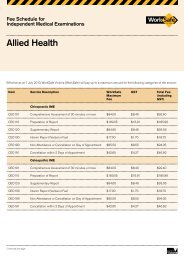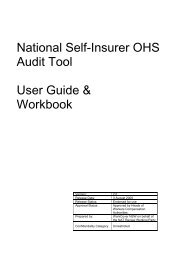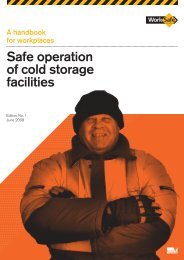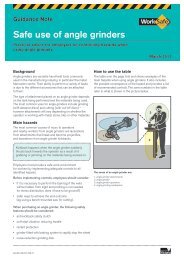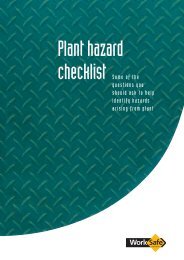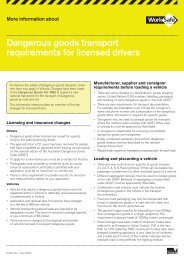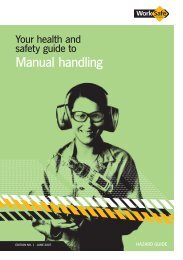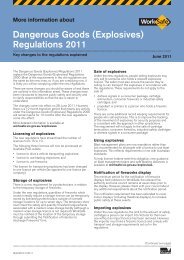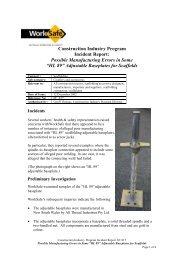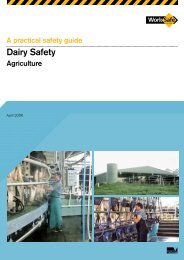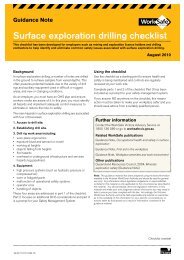a guide to safety in the wood products ... - WorkSafe Victoria
a guide to safety in the wood products ... - WorkSafe Victoria
a guide to safety in the wood products ... - WorkSafe Victoria
Create successful ePaper yourself
Turn your PDF publications into a flip-book with our unique Google optimized e-Paper software.
A GUIDE TO SAFETYIN THE WOOD PRODUCTSMANUFACTURING INDUSTRY1ST EDITIONMARCH 2007MANUFACTURING
* NEW Dangerous Goods (S<strong>to</strong>rage and Handl<strong>in</strong>g) Regulations 2012On 1 December 2012, <strong>the</strong> Dangerous Goods (S<strong>to</strong>rage and Handl<strong>in</strong>g) Regulations2012 (DG (S&H) Regulations 2012) replaced <strong>the</strong> Dangerous Goods (S<strong>to</strong>rageand Handl<strong>in</strong>g) Interim Regulations 2011 (Interim Regulations) which expired onthis date. The DG (S&H) Regulations 2012 have reta<strong>in</strong>ed most of <strong>the</strong> legalrequirements conta<strong>in</strong>ed <strong>in</strong> <strong>the</strong> Interim Regulations. There are only a small numberof changes. This document has not yet been updated <strong>to</strong> reflect <strong>the</strong> changes<strong>in</strong>troduced by <strong>the</strong> DG (S&H) Regulations 2012. More <strong>in</strong>formation on <strong>the</strong> keychanges <strong>in</strong>troduced by <strong>the</strong>se new regulations can be found <strong>in</strong> <strong>the</strong> guidance titledInformation about: Key changes <strong>to</strong> dangerous goods s<strong>to</strong>rage and handl<strong>in</strong>grequirements available at worksafe.vic.gov.au/dgkeychanges and More<strong>in</strong>formation about: Incident report<strong>in</strong>g available atworksafe.vic.gov.au/<strong>in</strong>cidentreport<strong>in</strong>g
CONTENTSINTRODUCTION . . . . . . . . . . . . . . . . . . . . . . . . . . . . . . . . . . . 2The legal framework . . . . . . . . . . . . . . . . . . . . . . . . . . 2Hazard Identification, Risk Assessmentand Risk Control . . . . . . . . . . . . . . . . . . . . . . . . . . . . . 2Consultation . . . . . . . . . . . . . . . . . . . . . . . . . . . . . . . . 3‘Reasonably practicable’ control measures . . . . . . . . 4Information for employers . . . . . . . . . . . . . . . . . . . . . 41. PLANT . . . . . . . . . . . . . . . . . . . . . . . . . . . . . . . . . . . . . . . . . 6Guard<strong>in</strong>g . . . . . . . . . . . . . . . . . . . . . . . . . . . . . . . . . . . 8Us<strong>in</strong>g hand <strong>to</strong>ols . . . . . . . . . . . . . . . . . . . . . . . . . . . . 112. MANUAL HANDLING AT THE WORKPLACE . . . . . 15Manual Handl<strong>in</strong>g and Musculoskeletal Disorders . . 16Removal of raw material from s<strong>to</strong>rage . . . . . . . . . . 18Transport of materials on <strong>the</strong> shop floor . . . . . . . . . 20Handl<strong>in</strong>g trolleys . . . . . . . . . . . . . . . . . . . . . . . . . . . . 23Manufactur<strong>in</strong>g product at workstations . . . . . . . . . . 24Unload<strong>in</strong>g f<strong>in</strong>ished <strong>products</strong> from<strong>the</strong> production l<strong>in</strong>e . . . . . . . . . . . . . . . . . . . . . . . . . . 26Load<strong>in</strong>g f<strong>in</strong>ished product . . . . . . . . . . . . . . . . . . . . . 28Unload<strong>in</strong>g product and on-site <strong>in</strong>stallation . . . . . . . . 303. MAINTENANCE AND CLEANING . . . . . . . . . . . . . . . 344. ENVIRONMENT . . . . . . . . . . . . . . . . . . . . . . . . . . . . . . . 35Noise . . . . . . . . . . . . . . . . . . . . . . . . . . . . . . . . . . . . . 36Wood dust . . . . . . . . . . . . . . . . . . . . . . . . . . . . . . . . 37Dangerous goods and hazardous substances. . . . . 37Light<strong>in</strong>g . . . . . . . . . . . . . . . . . . . . . . . . . . . . . . . . . . . 38Housekeep<strong>in</strong>g . . . . . . . . . . . . . . . . . . . . . . . . . . . . . . 39Plant layout . . . . . . . . . . . . . . . . . . . . . . . . . . . . . . . . 39Protective cloth<strong>in</strong>g and equipment (PPE) . . . . . . . . 39OTHER USEFUL GUIDANCE MATERIAL . . . . . . . . . . 41ACKNOWLEDGEMENTS . . . . . . . . . . . . . . . . . . . . . . . 42<strong>WorkSafe</strong> Vic<strong>to</strong>ria is a division of <strong>the</strong> Vic<strong>to</strong>rian WorkCover Authority.The <strong>in</strong>formation presented <strong>in</strong> A Guide <strong>to</strong> Safety <strong>in</strong> <strong>the</strong> Wood Products Manufactur<strong>in</strong>g Industry is <strong>in</strong>tended for general use only. It should not be viewed as a def<strong>in</strong>itive <strong>guide</strong> <strong>to</strong> <strong>the</strong>law, and should be read <strong>in</strong> conjunction with <strong>the</strong> Occupational Health and Safety Act 2004.Whilst every effort has been made <strong>to</strong> ensure <strong>the</strong> accuracy and completeness of <strong>the</strong> <strong>guide</strong>, advice conta<strong>in</strong>ed here<strong>in</strong> may not apply <strong>in</strong> every circumstance. Accord<strong>in</strong>gly, <strong>the</strong> Vic<strong>to</strong>rianWorkCover Authority (VWA) cannot be held responsible, and extends no warranties as <strong>to</strong>:• <strong>the</strong> suitability of <strong>the</strong> <strong>in</strong>formation for any particular purpose;• actions taken by third parties as a result of <strong>in</strong>formation conta<strong>in</strong>ed <strong>in</strong> A Guide <strong>to</strong> Safety <strong>in</strong> <strong>the</strong> Wood Products Manufactur<strong>in</strong>g Industry.This publication is protected by copyright. The Vic<strong>to</strong>rian WorkCover Authority (VWA) encourages <strong>the</strong> free transfer, copy<strong>in</strong>g and pr<strong>in</strong>t<strong>in</strong>g of this publication if such activities support<strong>the</strong> purposes and <strong>in</strong>tent for which <strong>the</strong> publication was developed.WORKSAFE VICTORIA / A GUIDE TO SAFETY IN THE WOOD PRODUCTS MANUFACTURING INDUSTRY 1
INTRODUCTIONThis <strong>guide</strong> demonstrates <strong>WorkSafe</strong> Vic<strong>to</strong>ria’s expectations on how <strong>to</strong> bestelim<strong>in</strong>ate or reduce <strong>the</strong> risk of <strong>in</strong>juries <strong>in</strong> <strong>the</strong> <strong>wood</strong> <strong>products</strong> manufactur<strong>in</strong>g<strong>in</strong>dustry. Many risk controls detailed <strong>in</strong> this <strong>guide</strong> have already been implemented<strong>in</strong> <strong>the</strong> <strong>in</strong>dustry <strong>in</strong> Vic<strong>to</strong>ria.THE LEGAL FRAMEWORKThere is a legislative framework around controll<strong>in</strong>g risk <strong>in</strong> consultation with Healthand Safety Representatives and employees with<strong>in</strong> <strong>the</strong> workplace and this <strong>guide</strong>shows how <strong>to</strong> comply with <strong>the</strong> Occupational Health and Safety Act 2004.HAZARD IDENTIFICATION, RISK ASSESSMENT AND RISK CONTROLHazard identificationThis <strong>guide</strong> identifies tasks <strong>in</strong> <strong>the</strong> <strong>wood</strong> <strong>products</strong> manufactur<strong>in</strong>g <strong>in</strong>dustry that arehazardous and can result <strong>in</strong> <strong>in</strong>juries. However; it is not a comprehensive list of allhazardous tasks <strong>in</strong> <strong>the</strong> <strong>in</strong>dustry.Risk assessmentFur<strong>the</strong>r, this <strong>guide</strong> cannot replace <strong>the</strong> requirement for risk assessment and riskcontrol as <strong>the</strong> risk of an <strong>in</strong>jury will vary depend<strong>in</strong>g on <strong>the</strong> circumstances <strong>in</strong> yourworkplace. To ensure a reduction <strong>in</strong> <strong>in</strong>juries, employers should review risks anddevelop and implement a plan for controls – this should be done <strong>in</strong> consultationwith employees.2 WORKSAFE VICTORIA / A GUIDE TO SAFETY IN THE WOOD PRODUCTS MANUFACTURING INDUSTRY
INTRODUCTIONRisk controlRisk controls are shown <strong>in</strong> this <strong>guide</strong>. It is <strong>the</strong> duty of an employer <strong>to</strong> carry out riskcontrol under <strong>the</strong> Consolidated Occupational Health and Safety Regulation 2007 thatcome <strong>in</strong><strong>to</strong> effect on 1 July 2007 replac<strong>in</strong>g <strong>the</strong> current regulations.These require <strong>the</strong> follow<strong>in</strong>g actions <strong>to</strong> be taken:1. elim<strong>in</strong>ate <strong>the</strong> risk2. if it is not practicable <strong>to</strong> elim<strong>in</strong>ate <strong>the</strong> risk, reduce <strong>the</strong> risk so far as is practicable.In ei<strong>the</strong>r case, <strong>the</strong> risk can be controlled by any of <strong>the</strong> follow<strong>in</strong>g ways:a. alter<strong>in</strong>g <strong>the</strong> workplace or environmental conditionsb. alter<strong>in</strong>g <strong>the</strong> systems of workc. chang<strong>in</strong>g <strong>the</strong> objectsd. us<strong>in</strong>g mechanical aids.A comb<strong>in</strong>ation of controls often gives <strong>the</strong> best solution.Consult<strong>in</strong>g Health and Safety Representatives and employees, and triall<strong>in</strong>gproposed solutions will determ<strong>in</strong>e if <strong>the</strong>y are right for your workplace or iffur<strong>the</strong>r modifications or different controls are required. It is necessary <strong>to</strong>moni<strong>to</strong>r <strong>the</strong> success or o<strong>the</strong>rwise of <strong>the</strong> controls implemented.Provision of <strong>in</strong>formation, tra<strong>in</strong><strong>in</strong>g and <strong>in</strong>struction cannot be used as <strong>the</strong> soleor primary way of controll<strong>in</strong>g <strong>the</strong> risk unless all o<strong>the</strong>r ways <strong>to</strong> control risk arenot practicable.Where tra<strong>in</strong><strong>in</strong>g is provided, it must be both task specific and competency based <strong>in</strong>order <strong>to</strong> be effective. Supervisors must <strong>the</strong>mselves be competent <strong>in</strong> how <strong>to</strong> bestuse specific risk controls and must be supported <strong>in</strong> this role. There should also beappropriate supervision of <strong>safety</strong> as well as production.You should always check <strong>the</strong> legislation referred <strong>to</strong> <strong>in</strong> this material and make yourown judgement about what action you may need <strong>to</strong> take <strong>to</strong> ensure you havecomplied with <strong>the</strong> law.Note: This <strong>guide</strong> should be used <strong>in</strong> conjunction with <strong>the</strong> Occupational Health andSafety (Manual Handl<strong>in</strong>g) Regulations 1999, Occupational Health and Safety (Plant)Regulations 1995 and <strong>the</strong> relevant codes of practice. On 1 July 2007 <strong>the</strong> newconsolidated regulations will come <strong>in</strong><strong>to</strong> effect replac<strong>in</strong>g <strong>the</strong> current regulations.CONSULTATIONAll employers are required <strong>to</strong> consult <strong>the</strong>ir employees, so far as reasonablypracticable, on matters that may directly affect employees’ health, <strong>safety</strong> orwelfare. This <strong>in</strong>cludes consultation with <strong>in</strong>dependent contrac<strong>to</strong>rs and anyemployees of that <strong>in</strong>dependent contrac<strong>to</strong>r. Where <strong>the</strong>re are elected Health andSafety Representatives <strong>the</strong> employer must consult <strong>the</strong>m on hazard identification,risk assessment, and risk control as well as any proposed changes <strong>in</strong> <strong>the</strong>workplace, plant, substances or work processes that could impact on workers’health, <strong>safety</strong> or welfare. It is important that HSR’s have access <strong>to</strong> tra<strong>in</strong><strong>in</strong>g <strong>in</strong> <strong>the</strong>irroles. HSR’s and deputy HSR’s have a legal entitlement <strong>to</strong> attend an <strong>in</strong>itial five dayOHS representatives course and an annual refresher course with <strong>the</strong> tra<strong>in</strong><strong>in</strong>gprovider of <strong>the</strong>ir choice.The duty <strong>to</strong> consult recognises that employee <strong>in</strong>put and participation improvesdecision-mak<strong>in</strong>g about health and <strong>safety</strong> matters. Consultation between employersand employees is an essential part of effectively manag<strong>in</strong>g health and <strong>safety</strong> atwork. It is a legal requirement and is a valuable means of improv<strong>in</strong>g health and<strong>safety</strong> outcomes.Through consultation, employers can become more aware of hazards and OHSissues experienced by employees – <strong>the</strong>y can also provide suggestions about how<strong>to</strong> solve OHS problems. Employee participation allows <strong>the</strong>m <strong>to</strong> contribute <strong>to</strong>determ<strong>in</strong><strong>in</strong>g how <strong>the</strong> work can be done safely.It is important <strong>to</strong> remember that consultation is a form of negotiation and notsimply a ‘notification of change’ process. This process allows for issues <strong>to</strong> bediscussed and <strong>the</strong> shar<strong>in</strong>g of ideas across all levels of <strong>the</strong> organisation <strong>in</strong> anattempt <strong>to</strong> f<strong>in</strong>d <strong>the</strong> most practicable solution <strong>to</strong> identified hazards or issues on-site.WORKSAFE VICTORIA / A GUIDE TO SAFETY IN THE WOOD PRODUCTS MANUFACTURING INDUSTRY 3
INTRODUCTIONFor more <strong>in</strong>formation on <strong>the</strong> duty <strong>to</strong> consult, please refer <strong>to</strong> <strong>the</strong> follow<strong>in</strong>g<strong>WorkSafe</strong> publications:• Talk<strong>in</strong>g Safety Toge<strong>the</strong>r and Consultation – A User’s Guide• Information for Employees on Health and Safety• Employee Representation Guide, and• Information for Health and Safety Representatives‘REASONABLY PRACTICABLE’ CONTROL MEASURESThe Occupational Health and Safety Act 2004 expla<strong>in</strong>s what must be taken <strong>in</strong><strong>to</strong>account when decid<strong>in</strong>g if someth<strong>in</strong>g is ‘reasonably practicable’. In general terms,<strong>the</strong> fac<strong>to</strong>rs <strong>to</strong> be considered are:• <strong>the</strong> likelihood of <strong>the</strong> hazard or risk concerned eventuat<strong>in</strong>g• <strong>the</strong> degree of harm that would result if <strong>the</strong> hazard or risk eventuated• what you know, or ought reasonably <strong>to</strong> know, about <strong>the</strong> hazard or risk and anyways of elim<strong>in</strong>at<strong>in</strong>g or reduc<strong>in</strong>g <strong>the</strong> hazard or risk• <strong>the</strong> availability and suitability of ways <strong>to</strong> elim<strong>in</strong>ate or reduce <strong>the</strong> hazard or risk• <strong>the</strong> cost of elim<strong>in</strong>at<strong>in</strong>g or reduc<strong>in</strong>g <strong>the</strong> hazard or riskThis <strong>guide</strong> shares <strong>in</strong>formation on what you know, or ought reasonably <strong>to</strong> know,and <strong>the</strong>refore what you should reasonably do. It is expected that employers,HSR’s, employees and <strong>WorkSafe</strong> <strong>in</strong>spec<strong>to</strong>rs will use this <strong>in</strong>formation <strong>to</strong> forman op<strong>in</strong>ion about suitable health and <strong>safety</strong> risk controls, under <strong>the</strong> test of‘reasonable practicability’.INFORMATION FOR EMPLOYERSThe use of contrac<strong>to</strong>rs, labour hire employees and tra<strong>in</strong>ees is not uncommon <strong>in</strong><strong>the</strong> <strong>wood</strong> <strong>products</strong> manufactur<strong>in</strong>g <strong>in</strong>dustry. These workers are <strong>the</strong> responsibilityof <strong>the</strong> host employer if <strong>the</strong>y are engaged <strong>to</strong> work on site.Host organisations are deemed <strong>to</strong> be employers of contrac<strong>to</strong>rs – and <strong>the</strong>ir directemployees – <strong>in</strong> relation <strong>to</strong> matters over which <strong>the</strong>y have control. Therefore, bothlabour hire companies and host organisations have <strong>the</strong> duty <strong>to</strong> ensure labour hireworkers are provided with safe workplaces.Before enter<strong>in</strong>g <strong>in</strong><strong>to</strong> a labour hire worker contract, both <strong>the</strong> labour hire companyand host organisation should ensure that:• tra<strong>in</strong><strong>in</strong>g, skills and experience of workers are verified and match <strong>the</strong> needsof <strong>the</strong> task• identification, assessment and control of all <strong>the</strong> risks associated with <strong>the</strong> taskmust be completed before <strong>the</strong> work commences• <strong>the</strong> worker is <strong>in</strong>ducted <strong>in</strong><strong>to</strong> systems of work• <strong>the</strong> worker is adequately supervised• <strong>the</strong> worker has <strong>the</strong> opportunity <strong>to</strong> consult with both <strong>the</strong> on-hire employer andhost organisation• <strong>the</strong> worker knows what <strong>to</strong> do when health and <strong>safety</strong> issues arise <strong>in</strong> <strong>the</strong>host’s workplace.There is specific guidance for both host employers and labour hire agenciesavailable <strong>in</strong> hardcopy and on <strong>the</strong> <strong>WorkSafe</strong> website.Management tra<strong>in</strong><strong>in</strong>g is available for employers on <strong>the</strong> pr<strong>in</strong>ciples of occupationalhealth and <strong>safety</strong>• host employer guidance <strong>in</strong>formation: Manag<strong>in</strong>g <strong>the</strong> <strong>safety</strong> of labour hire workers• labour hire agencies: Manag<strong>in</strong>g <strong>the</strong> <strong>safety</strong> of on-hired workersFor fur<strong>the</strong>r <strong>in</strong>formation visit www.worksafe.vic.gov.au4 WORKSAFE VICTORIA / A GUIDE TO SAFETY IN THE WOOD PRODUCTS MANUFACTURING INDUSTRY
INTRODUCTIONHOW TO USE THIS GUIDEThis <strong>guide</strong> provides examples of tasks undertaken <strong>in</strong> <strong>wood</strong> <strong>products</strong>manufactur<strong>in</strong>g, but it does not cover all tasks. Therefore, it is important <strong>to</strong> reviewyour own operations and apply some of <strong>the</strong> solutions or pr<strong>in</strong>ciples shown.The red, amber and green or ‘traffic light’ format used throughout this <strong>guide</strong> canhelp you identify high risk activities and assess your workplace, allow<strong>in</strong>g you <strong>to</strong>implement safer work practices. The rationale is simple: <strong>to</strong> reduce <strong>in</strong>jury rates andcompensation claims, high risk situations must be addressed.If you are able <strong>to</strong> tick any of <strong>the</strong> boxes <strong>in</strong> <strong>the</strong> red which represent high riskactivities <strong>the</strong>n you should read fur<strong>the</strong>r about <strong>the</strong> reduced risk and low riskcontrols shown.If high risk practices are followed <strong>in</strong> your workplace, you should determ<strong>in</strong>e if youcan implement <strong>the</strong> solutions <strong>in</strong> <strong>the</strong> green column. If this isn’t practicable, put <strong>in</strong>place <strong>the</strong> comparable practice <strong>in</strong> <strong>the</strong> amber column as a reduced risk solution.In <strong>the</strong> amber and green columns, <strong>the</strong> solutions listed first are preferred and willgenerally be more effective than solutions <strong>to</strong>wards <strong>the</strong> bot<strong>to</strong>m of <strong>the</strong> column.Solutions <strong>in</strong> <strong>the</strong> amber and green sections <strong>in</strong> this <strong>guide</strong> provide some differen<strong>to</strong>ptions. This is because <strong>the</strong> tasks, and hence <strong>the</strong> risk, will vary accord<strong>in</strong>g <strong>to</strong> <strong>the</strong>specifics at your workplace.HIGH RISKThe practices <strong>in</strong> <strong>the</strong> red boxes or column should not be used <strong>in</strong> workplaces;an employer who allows <strong>the</strong>se practices <strong>to</strong> be used is likely <strong>to</strong> be <strong>in</strong> breachof OHS legislationINTERIM WORK PRACTICE(MEDIUM RISK)The solutions <strong>in</strong> <strong>the</strong> amber column areless effective <strong>in</strong> reduc<strong>in</strong>g riskcompared <strong>to</strong> those <strong>in</strong> <strong>the</strong> greencolumn, and would be regularlyreviewed with <strong>the</strong> aim <strong>to</strong> move<strong>to</strong>wards higher order solutions (green)PREFERRED SOLUTION(LOW RISK)The solutions <strong>in</strong> <strong>the</strong> green column are<strong>the</strong> most effective at reduc<strong>in</strong>g risk andshould be regarded as <strong>the</strong> target forall workplacesRed, high risk, columnSolutionsshouldcont<strong>in</strong>ue<strong>to</strong> bereviewedas higherordercontrolsbecomemorepracticableAre any solutions from<strong>the</strong> green columnreasonably practicablefor <strong>the</strong> workplace?(Undertake practicabilitytest)NOImplement solutionsfrom <strong>the</strong> amber,reduced risk, columnYESImplement asolution from <strong>the</strong>green, preferredsolution, columnNote: If you are able <strong>to</strong> demonstrate an appropriate risk assessment process has been undertakenand you are able <strong>to</strong> verify that <strong>the</strong> ‘reasonably practicable’ test has been applied <strong>to</strong> <strong>the</strong> controls youimplement, <strong>the</strong>n control measures <strong>in</strong> <strong>the</strong> amber range may be practicable <strong>in</strong> some circumstances.WORKSAFE VICTORIA / A GUIDE TO SAFETY IN THE WOOD PRODUCTS MANUFACTURING INDUSTRY 5
1PLANTGUARDINGUSING HAND TOOLS6 WORKSAFE VICTORIA / A GUIDE TO SAFETY IN THE WOOD PRODUCTS MANUFACTURING INDUSTRY
PLANTPLANT IN WOOD PRODUCTS MANUFACTURINGWhat is plant?Plant can be def<strong>in</strong>ed as an apparatus, mach<strong>in</strong>e, appliance, equipment or <strong>to</strong>ol used<strong>to</strong> enhance <strong>the</strong> capacity of employees <strong>to</strong> perform tasks. Plant can be a simplelever, a <strong>to</strong>ol or a complex mach<strong>in</strong>e.A person operat<strong>in</strong>g <strong>wood</strong>work<strong>in</strong>g plant is often apply<strong>in</strong>g a cutt<strong>in</strong>g blade at highspeed <strong>to</strong> timber. Some of <strong>the</strong> processes <strong>in</strong>cluded <strong>in</strong> <strong>wood</strong> product manufactur<strong>in</strong>g<strong>in</strong>clude cutt<strong>in</strong>g, rout<strong>in</strong>g, thickness<strong>in</strong>g, shap<strong>in</strong>g, tenon<strong>in</strong>g, etc. Manufacturers areoften mak<strong>in</strong>g <strong>products</strong> <strong>to</strong> order ra<strong>the</strong>r than high volume production. This requiresplant <strong>to</strong> be frequently set-up for different product runs. There is also a tendencyfor ‘one-off’ cuts or shapes <strong>to</strong> be required <strong>in</strong> normal operation.For <strong>the</strong>se reasons alone, it is paramount that plant be operated <strong>in</strong> a safe manner.In many cases, <strong>in</strong> order <strong>to</strong> mach<strong>in</strong>e timber it is necessary <strong>to</strong> have an exposedblade <strong>to</strong> <strong>the</strong> timber. Employers must ensure, so far as is reasonably practicable,that all plant is guarded <strong>to</strong> prevent an opera<strong>to</strong>r com<strong>in</strong>g <strong>in</strong><strong>to</strong> contact with exposedblades or trapp<strong>in</strong>g spaces.Employers must ensure <strong>in</strong>troduc<strong>in</strong>g risk controls <strong>to</strong> reduce <strong>the</strong> risk of <strong>in</strong>juries doesnot <strong>in</strong>troduce o<strong>the</strong>r hazards or risks <strong>in</strong><strong>to</strong> a system of work. For example;• <strong>the</strong> <strong>in</strong>troduction of a forklift requires <strong>the</strong> implementation of a trafficmanagement plan <strong>to</strong> segregate pedestrians from forklifts• where mechanical aids or o<strong>the</strong>r load shift<strong>in</strong>g equipment is used, such aspowered pallet jacks, ensure employees are tra<strong>in</strong>ed and competent <strong>in</strong> its use• when transferr<strong>in</strong>g cab<strong>in</strong>et carcases us<strong>in</strong>g lift<strong>in</strong>g gear, ensure loads are carriedwith<strong>in</strong> <strong>the</strong> manufacturer’s safe work<strong>in</strong>g load (SWL) and implement a program<strong>to</strong> moni<strong>to</strong>r damage <strong>to</strong> shackles, sl<strong>in</strong>gs etc• changes <strong>to</strong> equipment will require a plant risk assessment be conducted <strong>to</strong>ensure employees are not <strong>in</strong>jured by newly <strong>in</strong>troduced hazards such as trapp<strong>in</strong>gpo<strong>in</strong>ts or <strong>in</strong>-runn<strong>in</strong>g nip po<strong>in</strong>ts and that controls are put <strong>in</strong> place if risk is present.WORKSAFE VICTORIA / A GUIDE TO SAFETY IN THE WOOD PRODUCTS MANUFACTURING INDUSTRY 7
PLANTTra<strong>in</strong><strong>in</strong>g and supervisionEmployees who operate, ma<strong>in</strong>ta<strong>in</strong> or are required <strong>to</strong> work <strong>in</strong> close proximityof plant must be tra<strong>in</strong>ed and supervised <strong>in</strong> <strong>the</strong> operation of that plant.Complacency has been identified as one of <strong>the</strong> fac<strong>to</strong>rs lead<strong>in</strong>g <strong>to</strong> many <strong>in</strong>jurieswhen operat<strong>in</strong>g new plant. The <strong>in</strong>experience of employees is a potential hazardand employers should ensure new or <strong>in</strong>experienced employees are not left <strong>to</strong>work alone on hazardous plant. O<strong>the</strong>r risk control solutions that can be used <strong>in</strong>clude:• ensur<strong>in</strong>g <strong>the</strong> right mach<strong>in</strong>e is used for <strong>the</strong> right purpose• controll<strong>in</strong>g production output <strong>in</strong> <strong>the</strong> workplace <strong>to</strong> ensure <strong>safety</strong> is still a priority• a grad<strong>in</strong>g system related <strong>to</strong> tra<strong>in</strong><strong>in</strong>g for opera<strong>to</strong>rs and ma<strong>in</strong>tenance• consultation between management and employees about guard<strong>in</strong>g and mach<strong>in</strong>eoperat<strong>in</strong>g procedures.Push pads and push sticksThese <strong>to</strong>ols are used as aides <strong>to</strong> assist opera<strong>to</strong>rs when us<strong>in</strong>g <strong>wood</strong> work<strong>in</strong>g plant.For <strong>in</strong>stance, a push pad is used <strong>to</strong> better isolate <strong>the</strong> opera<strong>to</strong>r’s hands from <strong>the</strong>cutt<strong>in</strong>g blade on a buzzer. Push sticks are often used <strong>to</strong> push timber through arip saw. When us<strong>in</strong>g <strong>the</strong>se mechanical aids <strong>the</strong> follow<strong>in</strong>g adm<strong>in</strong>istrative controlsshould be followed:Push sticks should never be used <strong>to</strong>:• remove off cuts from a runn<strong>in</strong>g mach<strong>in</strong>e• heat up a blade by apply<strong>in</strong>g a friction force us<strong>in</strong>g <strong>the</strong> stickKick backA common problem associated with <strong>the</strong> manufacture of timber <strong>products</strong> is <strong>the</strong>‘kick back’ associated with rotat<strong>in</strong>g plant and mach<strong>in</strong>ery. This poses a risk <strong>to</strong> <strong>the</strong>opera<strong>to</strong>r when <strong>the</strong> timber be<strong>in</strong>g sawn or mach<strong>in</strong>ed b<strong>in</strong>ds <strong>to</strong> <strong>the</strong> blade and ‘kicksback’ <strong>to</strong>wards <strong>the</strong>m. In <strong>the</strong>se <strong>in</strong>stances <strong>the</strong> guard<strong>in</strong>g or riv<strong>in</strong>g knives may havebeen removed. O<strong>the</strong>r situations that can lead <strong>to</strong> issues with ‘kick back’ <strong>in</strong>cludeknots <strong>in</strong> <strong>the</strong> timber or us<strong>in</strong>g <strong>the</strong> wrong <strong>to</strong>ol (ei<strong>the</strong>r <strong>to</strong>o powerful or not powerfulenough) for <strong>the</strong> task, or a saw blade that is blunt or worn.GUARDINGThere are many types of guard<strong>in</strong>g systems available <strong>to</strong> guard dangerous parts ofmach<strong>in</strong>ery <strong>to</strong> prevent bodily access. If guard<strong>in</strong>g is <strong>to</strong> be used as a control measure,<strong>the</strong> employer is required <strong>to</strong> ensure that any guard designed for <strong>the</strong> plant will, sofar as is practicable, prevent access <strong>to</strong> <strong>the</strong> danger po<strong>in</strong>t or area of <strong>the</strong> plant.The guard<strong>in</strong>g that is <strong>to</strong> be <strong>in</strong>stalled on<strong>to</strong> plant should be designed and <strong>in</strong>stalled bya suitably qualified and competent person. There may be <strong>in</strong>stances where <strong>the</strong>guard<strong>in</strong>g is <strong>to</strong> be designed and <strong>in</strong>stalled by an electrical contrac<strong>to</strong>r or someoneo<strong>the</strong>r than <strong>the</strong> manufacturer or supplier. It is important <strong>to</strong> ensure whoever designsand <strong>in</strong>stalls guard<strong>in</strong>g is familiar with <strong>the</strong> current Australian Standard AS4024 –2006, Safety of Mach<strong>in</strong>ery, Part 1201: General Pr<strong>in</strong>ciples – Basic term<strong>in</strong>ology andmethodology and <strong>the</strong> current Australian Standard that relates <strong>to</strong> <strong>the</strong> equipmentbe<strong>in</strong>g guarded.The plant guard<strong>in</strong>g hierarchy is as follows:1. Permanently fixed physical barrier2. Interlocked physical barrier3. Physical barrier (fixed guard)4. Presence sens<strong>in</strong>g system8 WORKSAFE VICTORIA / A GUIDE TO SAFETY IN THE WOOD PRODUCTS MANUFACTURING INDUSTRY
PLANTPermanently fixed physical barrierPermanently fixed physical barriers are normally used where <strong>the</strong>re is norequirement for access dur<strong>in</strong>g operation, ma<strong>in</strong>tenance or clean<strong>in</strong>g of <strong>the</strong> plant.The underside of <strong>the</strong> sp<strong>in</strong>dlemoulder is a permanently fixedguard. The hous<strong>in</strong>g of <strong>the</strong> mach<strong>in</strong>eprevents access <strong>to</strong> <strong>the</strong> mo<strong>to</strong>r, driveshaft or o<strong>the</strong>r dangerous parts.Interlocked physical barrierAn <strong>in</strong>terlock guard is one that is moveable or has a moveable part. The movemen<strong>to</strong>f <strong>the</strong> guard <strong>in</strong>teracts with <strong>the</strong> dangerous parts of <strong>the</strong> plant or <strong>the</strong> control systemof <strong>the</strong> plant <strong>to</strong> prevent motion of <strong>the</strong> dangerous parts while <strong>the</strong> guard is open. The<strong>in</strong>terlock<strong>in</strong>g system must be designed <strong>to</strong> fail <strong>to</strong> <strong>safety</strong> so it can not be defeated.The run-down time needs <strong>to</strong> be taken <strong>in</strong><strong>to</strong> account so that access is only availablewhen sufficient time has lapsed for <strong>the</strong> motion of <strong>the</strong> danger parts has ceased.The cover<strong>in</strong>g doors on <strong>the</strong> saw are<strong>in</strong>terlocked so that when <strong>the</strong> doorsare opened, <strong>the</strong> systems shut downpower and air <strong>to</strong> <strong>the</strong> saw.WORKSAFE VICTORIA / A GUIDE TO SAFETY IN THE WOOD PRODUCTS MANUFACTURING INDUSTRY 9
PLANTPhysical barrier (fixed guard)A fixed guard (with no mov<strong>in</strong>g parts) that prevents access <strong>to</strong> <strong>the</strong> dangerous part of<strong>the</strong> mach<strong>in</strong>ery and provides protection while <strong>the</strong> guard is <strong>in</strong> its <strong>in</strong>tended position isneeded. The physical barrier can only be altered or removed by <strong>the</strong> use of a <strong>to</strong>ol.A h<strong>in</strong>ged door acts as a physicalbarrier prevent<strong>in</strong>g access <strong>to</strong> <strong>the</strong>drive wheel of a bandsaw. The dooris bolted shut with non-conventionalhead bolts that can only be removedus<strong>in</strong>g a special <strong>to</strong>ol.Where better vision of <strong>the</strong> cutt<strong>in</strong>gblade is required, use polycarbonateguards (e.g. panel saw).Presence sens<strong>in</strong>g systemThese guards are usually an unseen barrier created by pho<strong>to</strong>electric or similardevices capable of electronically detect<strong>in</strong>g <strong>in</strong>trusion <strong>in</strong><strong>to</strong> <strong>the</strong> hazardous area ofa mach<strong>in</strong>e. The presence-sens<strong>in</strong>g system <strong>the</strong>n shuts off power <strong>to</strong> <strong>the</strong> plant andmay, depend<strong>in</strong>g on <strong>the</strong> plant, brake <strong>the</strong> exist<strong>in</strong>g motion.These systems are designed with a high level of reliability and are designed <strong>to</strong>‘fail <strong>to</strong> safe’ when <strong>the</strong> system is activated.Au<strong>to</strong>matic rout<strong>in</strong>g mach<strong>in</strong>e witha light curta<strong>in</strong> detection system<strong>to</strong> prevent access <strong>to</strong> <strong>the</strong> mach<strong>in</strong>e.10 WORKSAFE VICTORIA / A GUIDE TO SAFETY IN THE WOOD PRODUCTS MANUFACTURING INDUSTRY
PLANTUSING HAND TOOLSThe def<strong>in</strong>ition of ‘hand <strong>to</strong>ols’ used <strong>in</strong> this document is ‘a <strong>to</strong>ol used with aperson’s hands’.It <strong>in</strong>cludes:• <strong>to</strong>ols that are designed for force <strong>to</strong> be applied by <strong>the</strong> person, <strong>in</strong>clud<strong>in</strong>gscrewdrivers, hammers, chisels, hacksaws, etc, and• <strong>to</strong>ols where <strong>the</strong> force is applied by a power source but needs a person <strong>to</strong> hold<strong>the</strong> <strong>to</strong>ol such as portable electric or battery drills, sanders or saws, pneumaticimpulse <strong>to</strong>ols, spray guns or nail guns, etc.The Musculoskeletal disorders risks from hand <strong>to</strong>ol usage ma<strong>in</strong>ly result from:• Tool design – weight, shape, fit <strong>to</strong> user, vibration, recoil, shock load<strong>in</strong>g• Workstation design – size, shape and layout• Task design – frequency, duration, speed of <strong>to</strong>ol usage• Tool ma<strong>in</strong>tenance – poorly ma<strong>in</strong>ta<strong>in</strong>ed <strong>to</strong>ols may compromise <strong>safety</strong> and also<strong>in</strong>crease <strong>the</strong> effort required <strong>to</strong> use <strong>the</strong>m.Poor hand <strong>to</strong>ol design and excessive use of hand <strong>to</strong>ols are associated with chronicdisorders of <strong>the</strong> hand, wrist and forearm such as carpal tunnel syndrome and wristtendonitis. Major fac<strong>to</strong>rs affect<strong>in</strong>g <strong>the</strong> potential for <strong>in</strong>jury <strong>in</strong>clude:• Muscular effort <strong>in</strong> us<strong>in</strong>g <strong>to</strong>ols (hold<strong>in</strong>g, operat<strong>in</strong>g and guid<strong>in</strong>g) because of poorhandle design, or heavy, poorly balanced and/or poorly ma<strong>in</strong>ta<strong>in</strong>ed <strong>to</strong>ols• Static load<strong>in</strong>g of arm and shoulder muscles from hold<strong>in</strong>g <strong>to</strong>ols that can lead <strong>to</strong>fatigue when ma<strong>in</strong>ta<strong>in</strong>ed for prolonged periods, and eventually <strong>to</strong> <strong>in</strong>jury• Awkward wrist positions that mean a <strong>to</strong>ol is held with <strong>the</strong> wrist bent up, downor sideways caus<strong>in</strong>g additional muscular effort <strong>in</strong> us<strong>in</strong>g <strong>to</strong>ols• Contact stresses that result <strong>in</strong> pressure on tissues or jo<strong>in</strong>ts, such as <strong>to</strong>olspress<strong>in</strong>g <strong>in</strong><strong>to</strong> <strong>the</strong> palm at <strong>the</strong> base of <strong>the</strong> thumb where blood vessels andnerves pass through <strong>the</strong> hand. This contributes <strong>to</strong> <strong>the</strong> development of carpaltunnel syndrome• Wide grip span can cause tendon <strong>in</strong>jury known as ‘trigger f<strong>in</strong>ger’. The risk is<strong>in</strong>creased when force is exerted at <strong>the</strong> limits of <strong>the</strong> grip span.WORKSAFE VICTORIA / A GUIDE TO SAFETY IN THE WOOD PRODUCTS MANUFACTURING INDUSTRY 11
PLANTCONTROL OPTIONS - HAND TOOL SELECTIONWell ma<strong>in</strong>ta<strong>in</strong>ed <strong>to</strong>ols matched <strong>to</strong> <strong>the</strong> person and <strong>the</strong> task, used <strong>in</strong>frequently at well designed workstations do not causeharm. It is when <strong>the</strong>y do not match <strong>the</strong> person or <strong>the</strong> task or are used repeatedly and/or for long periods that hand <strong>to</strong>ol andwork area design become critical.The best hand <strong>to</strong>ol <strong>to</strong> select is one that:• matches <strong>the</strong> task you are do<strong>in</strong>g• fits <strong>the</strong> workspace available• reduces <strong>the</strong> force that needs <strong>to</strong> be applied• fits your hand• can be used <strong>in</strong> a comfortable position• is well ma<strong>in</strong>ta<strong>in</strong>ed.Fit <strong>the</strong> <strong>to</strong>ol <strong>to</strong> <strong>the</strong> person, not <strong>the</strong> person <strong>to</strong> <strong>the</strong> <strong>to</strong>olCHECKLIST - HAND TOOL USEAnswers <strong>in</strong> a red box <strong>in</strong>dicates <strong>the</strong> choice of hand <strong>to</strong>ol may not be appropriate for <strong>the</strong> task be<strong>in</strong>g performedYESNO1. Are <strong>to</strong>ols used which bend <strong>the</strong> wrist up, down or sideways?2. Are <strong>to</strong>ols selected which are:a) able <strong>to</strong> be used <strong>in</strong> ei<strong>the</strong>r hand?b) evenly balanced?c) designed for specific purpose?3. Are <strong>to</strong>ols of more than 1.5 kg used without aids <strong>to</strong> assist <strong>in</strong> support<strong>in</strong>g <strong>the</strong>m?4. Tool handle design. Are problems caused because <strong>the</strong>y:a) need <strong>to</strong> be held firmly through not hav<strong>in</strong>g good friction with <strong>the</strong> hand?b) are made of non-resilient material (e.g. metal, etc.)?c) dig <strong>in</strong><strong>to</strong> <strong>the</strong> palm area?d) require use of a wide grip span (scissors or pliers, etc.) which is excessive (more than 10cm) orcause discomfort?e) require a lot of force applied by <strong>the</strong> back of <strong>the</strong> f<strong>in</strong>gers and thumb <strong>to</strong> open <strong>the</strong> handles of <strong>to</strong>olssuch as pliers, scissors or shears?5. Tool handle dimensions:a) do <strong>the</strong>y have a grip diameter suitable for most workers?b) are <strong>the</strong>y long enough <strong>to</strong> pass along <strong>the</strong> whole hand/palm and allow all of <strong>the</strong> hand and f<strong>in</strong>gers <strong>to</strong>stay on <strong>the</strong> grip?6. Does <strong>the</strong> design of <strong>the</strong> trigger allow:a) use by only one hand?b) activation only by <strong>the</strong> f<strong>in</strong>ger tips?c) it <strong>to</strong> be locked on if activated for more than 30 seconds?7. Is <strong>the</strong>re repeated shock <strong>to</strong> <strong>the</strong> hand or wrist through <strong>to</strong>ol design, such as <strong>the</strong> reaction of power <strong>to</strong>olsafter <strong>the</strong> <strong>to</strong>rque limit is reached?8. Can <strong>to</strong>rque be resisted o<strong>the</strong>r than by muscle force?12 WORKSAFE VICTORIA / A GUIDE TO SAFETY IN THE WOOD PRODUCTS MANUFACTURING INDUSTRY
PLANTUs<strong>in</strong>g hand <strong>to</strong>olsReferr<strong>in</strong>g <strong>to</strong> <strong>the</strong> checklist above, does your task <strong>in</strong>volve <strong>the</strong> follow<strong>in</strong>g?HIGH RISKRISK CONTROL SOLUTIONSManual handl<strong>in</strong>g• Heavy <strong>to</strong>ols can cause awkward postures andexcessive force• Use lightweight or powered alternatives, if available• Tools should be presented at a comfortable heightfor <strong>the</strong> opera<strong>to</strong>rQuality• Cheap <strong>to</strong>ols have hazards associated with <strong>the</strong>m- high vibration- electrical <strong>safety</strong> (not double <strong>in</strong>sulated)- fractures of cutt<strong>in</strong>g blades- flimsy guards- lack of operat<strong>in</strong>g <strong>in</strong>structions- may not meet Australian Standards- noise levels- no fail safe protection• Use fibreglass and vibration cancell<strong>in</strong>g hammers,if required for manual hammer<strong>in</strong>g operations• Use double <strong>in</strong>sulated electrical power <strong>to</strong>ols and earthleakage circuit breakers for all electrical equipment• Restart and overload protection• Safety clutch• Ensure <strong>to</strong>ols meet Australian standards(AS/NZ 60745.1:2003)Air <strong>to</strong>ols• Can be large and awkward <strong>to</strong> operate <strong>in</strong> conf<strong>in</strong>ed areas• Require an air l<strong>in</strong>e <strong>to</strong> be attached at all times• Use smaller air <strong>to</strong>ols <strong>in</strong> conf<strong>in</strong>ed areas.• Use battery/gas powered <strong>to</strong>ols <strong>to</strong> reduce <strong>the</strong> needfor air l<strong>in</strong>esAir powered nail gun• Can be noisy• Incorrect air l<strong>in</strong>e connectionsCordless fram<strong>in</strong>g nail gun• Silencers on <strong>the</strong> air <strong>to</strong>ols <strong>to</strong> reduce <strong>the</strong> noise levels• Use correct connections for <strong>the</strong> <strong>to</strong>ols.WORKSAFE VICTORIA / A GUIDE TO SAFETY IN THE WOOD PRODUCTS MANUFACTURING INDUSTRY 13
PLANTHIGH RISKRISK CONTROL SOLUTIONSAir <strong>to</strong>olsPull BackReleaseTo disconnect2. Pull Back 1. Pull Back 3. ReleaseS<strong>in</strong>gleRidgeS<strong>in</strong>gle action air l<strong>in</strong>e connection• Us<strong>in</strong>g damaged or faulty air compressorsDouble action air l<strong>in</strong>e connection• Use well ma<strong>in</strong>ta<strong>in</strong>ed air compressorsDouble RidgeDamaged air compressorWell ma<strong>in</strong>ta<strong>in</strong>ed air compressor• Relocate air compressors outside <strong>to</strong> reduce noise• Use hose stands <strong>to</strong> keep air l<strong>in</strong>es off <strong>the</strong> groundStand with coiled air hose used<strong>to</strong> reduce clutter• Direct plumb<strong>in</strong>g of air l<strong>in</strong>es <strong>in</strong><strong>to</strong> workstations14 WORKSAFE VICTORIA / A GUIDE TO SAFETY IN THE WOOD PRODUCTS MANUFACTURING INDUSTRY
2MANUAL HANDLINGMANUAL HANDLING AND MUSCULOSKELETAL DISORDERSREMOVAL OF RAW MATERIAL FROM STORAGETRANSPORT OF MATERIALS ON THE SHOP FLOORHANDLING TROLLEYSMANUFACTURING PRODUCT AT WORKSTATIONSUNLOADING FINISHED PRODUCTSLOADING FINISHED PRODUCTUNLOADING AND ON-SITE INSTALLATIONWORKSAFE VICTORIA / A GUIDE TO SAFETY IN THE WOOD PRODUCTS MANUFACTURING INDUSTRY 15
MANUAL HANDLINGMANUAL HANDLING AND MUSCULOSKELETAL DISORDERSManual handl<strong>in</strong>gFor <strong>the</strong> <strong>wood</strong> <strong>products</strong> manufactur<strong>in</strong>g <strong>in</strong>dustry, manual handl<strong>in</strong>g covers a widerange of activities such as handl<strong>in</strong>g <strong>wood</strong> <strong>in</strong> and out of mach<strong>in</strong>ery, transport ofmaterials with<strong>in</strong> <strong>the</strong> workplace, load<strong>in</strong>g f<strong>in</strong>ished product for delivery, delivery andon-site <strong>in</strong>stallation. Many of <strong>the</strong>se tasks can result <strong>in</strong> musculoskeletal disordersand o<strong>the</strong>r types of <strong>in</strong>juries. However, not all manual handl<strong>in</strong>g is hazardous. In this<strong>in</strong>dustry, hazardous manual handl<strong>in</strong>g refers <strong>to</strong> manual handl<strong>in</strong>g with any of <strong>the</strong>follow<strong>in</strong>g characteristics:• repetitive or susta<strong>in</strong>ed application of force• repetitive or susta<strong>in</strong>ed awkward posture• repetitive or susta<strong>in</strong>ed movement• application of high force• exposure <strong>to</strong> susta<strong>in</strong>ed vibration• unstable or unbalanced loads or loads which are difficult <strong>to</strong> grasp or hold.Musculoskeletal disordersMusculoskeletal disorders (MSD) are sometimes referred <strong>to</strong> as ‘spra<strong>in</strong>s andstra<strong>in</strong>s’. It is a term used <strong>to</strong> describe a wide variety of <strong>in</strong>juries and diseases of <strong>the</strong>musculoskeletal system <strong>in</strong>clud<strong>in</strong>g <strong>in</strong>juries <strong>to</strong> jo<strong>in</strong>ts, ligaments, <strong>in</strong>tervertebral discsand o<strong>the</strong>r structures <strong>in</strong> <strong>the</strong> back and <strong>in</strong>juries <strong>to</strong> jo<strong>in</strong>ts, ligaments, tendons, musclesand nerves <strong>in</strong> <strong>the</strong> wrists, elbows, arms, shoulders, neck, abdomen (e.g. hernia),hips, knees and legs.Some of <strong>the</strong>se conditions are sometimes described as repetitive stra<strong>in</strong> <strong>in</strong>jury (RSI),occupational overuse syndrome (OOS), cumulative trauma disorder (CTD) andwork-related musculoskeletal disorder (WRMSD).In <strong>the</strong> Occupational Health and Safety (Manual Handl<strong>in</strong>g) Regulations 1999(Manual Handl<strong>in</strong>g Regulations), all of <strong>the</strong>se conditions are referred <strong>to</strong> asmusculoskeletal disorders (MSD).THE LEGAL FRAMEWORKThere is a legislative framework around controll<strong>in</strong>g risk and consultation <strong>in</strong> <strong>the</strong>workplace. This <strong>guide</strong> shows ways <strong>to</strong> assist with compliance with <strong>the</strong>Occupational Health and Safety (Manual Handl<strong>in</strong>g) Regulations 1999. Under <strong>the</strong>seregulations <strong>the</strong> employer has a legal duty <strong>to</strong>:• identify tasks <strong>in</strong>volv<strong>in</strong>g hazardous manual handl<strong>in</strong>g• assess <strong>the</strong> risk of develop<strong>in</strong>g a MSD associated with <strong>the</strong> task, and• control <strong>the</strong> risk by elim<strong>in</strong>at<strong>in</strong>g <strong>the</strong> risk or reduc<strong>in</strong>g it so far as isreasonably practicable.16 WORKSAFE VICTORIA / A GUIDE TO SAFETY IN THE WOOD PRODUCTS MANUFACTURING INDUSTRY
MANUAL HANDLINGHazard identificationThis <strong>guide</strong> identifies some tasks performed <strong>in</strong> <strong>the</strong> <strong>wood</strong> <strong>products</strong> <strong>in</strong>dustry thatare hazardous and known <strong>to</strong> have resulted <strong>in</strong> MSD. This is not <strong>to</strong> be taken as <strong>the</strong>complete list of all tasks <strong>in</strong>volv<strong>in</strong>g hazardous manual handl<strong>in</strong>g with<strong>in</strong> this <strong>in</strong>dustry.Risk assessmentThis <strong>guide</strong> follows <strong>the</strong> risk assessment format used <strong>in</strong> <strong>the</strong> <strong>WorkSafe</strong> publicationManual Handl<strong>in</strong>g (Code of Practice No. 25, 2000). It helps <strong>in</strong>dicate which riskfac<strong>to</strong>rs may be <strong>in</strong> your workplace and, <strong>in</strong> particular, demonstrates those high-riskwork practices which may put people at risk of develop<strong>in</strong>g MSD.The <strong>guide</strong> cannot replace <strong>the</strong> requirement for risk assessment and risk control,as <strong>the</strong> risk of develop<strong>in</strong>g MSD will vary depend<strong>in</strong>g on <strong>the</strong> circumstances <strong>in</strong> eachworkplace. To ensure a reduction <strong>in</strong> MSD, employers should review risks anddevelop and implement a plan for controls <strong>in</strong> consultation with employees.Risk controlRisk controls are shown <strong>in</strong> <strong>the</strong> <strong>guide</strong>. Under <strong>the</strong> Manual Handl<strong>in</strong>g Regulationsit is <strong>the</strong> duty of an employer <strong>to</strong> carry out risk controls <strong>in</strong>clud<strong>in</strong>g:1. elim<strong>in</strong>at<strong>in</strong>g <strong>the</strong> risk (e.g. redesign<strong>in</strong>g so as <strong>to</strong> elim<strong>in</strong>ate handl<strong>in</strong>g), or2. if it is not practicable <strong>to</strong> elim<strong>in</strong>ate <strong>the</strong> risk, reduce <strong>the</strong> risk so far as isreasonably practicable.In ei<strong>the</strong>r case, <strong>the</strong> risk can be controlled <strong>in</strong> any of <strong>the</strong> follow<strong>in</strong>g ways:a. alter<strong>in</strong>g <strong>the</strong> workplace or environmental conditions (e.g. height adjustablework surfaces)b. alter<strong>in</strong>g <strong>the</strong> systems of work (e.g. regular ma<strong>in</strong>tenance on equipment,job rotation, etc)c. chang<strong>in</strong>g <strong>the</strong> objects (e.g. us<strong>in</strong>g hand <strong>to</strong>ols that m<strong>in</strong>imise hand-arm vibration)d. us<strong>in</strong>g mechanical aids (e.g. pallet lifters, adjustable trolleys, approvedforklift attachments).GENERAL PRINCIPLES• Postures, movements and forces that are known<strong>to</strong> be associated with MSD should be elim<strong>in</strong>atedfrom <strong>the</strong> workplace where possible.• Physical changes <strong>to</strong> workplace design, layout andplant are more effective than adm<strong>in</strong>istrative riskcontrols such as tra<strong>in</strong><strong>in</strong>g.• To accommodate for different people and tasks,workstations should be quick and easy <strong>to</strong> adjust.• No employee should be required <strong>to</strong> rout<strong>in</strong>ely workabove <strong>the</strong>ir shoulder height or below <strong>the</strong>ir knees.• Keep loads close <strong>to</strong> <strong>the</strong> body.• Avoid extreme postures when exert<strong>in</strong>g high force.• Reduce hand-arm vibration from power <strong>to</strong>ols byselect<strong>in</strong>g <strong>the</strong> appropriate <strong>to</strong>ol, isolat<strong>in</strong>g vibration,reduc<strong>in</strong>g or dampen<strong>in</strong>g <strong>the</strong> <strong>to</strong>ol’s vibration, orreduc<strong>in</strong>g <strong>the</strong> time exposed <strong>to</strong> it.GREEN - LOW RISKAMBER - MEDIUM RISKRED - HIGH RISKWORKSAFE VICTORIA / A GUIDE TO SAFETY IN THE WOOD PRODUCTS MANUFACTURING INDUSTRY 17
MANUAL HANDLINGREMOVAL OF RAW MATERIAL FROM STORAGERaw materials are taken from <strong>the</strong> s<strong>to</strong>rage area and moved through<strong>to</strong> <strong>the</strong> beg<strong>in</strong>n<strong>in</strong>g of <strong>the</strong> manufactur<strong>in</strong>g process.Does <strong>the</strong> work <strong>in</strong>volve any of <strong>the</strong> follow<strong>in</strong>g?HIGH RISKTICKPush<strong>in</strong>g or pull<strong>in</strong>g objects that are hard <strong>to</strong> move or s<strong>to</strong>p, e.g. handl<strong>in</strong>g timber from <strong>the</strong> <strong>to</strong>p of a s<strong>to</strong>rage rackExert<strong>in</strong>g high force while <strong>in</strong> an awkward posture, e.g. handl<strong>in</strong>g heavy material from <strong>the</strong> groundRepetitive bend<strong>in</strong>g of <strong>the</strong> back more than 20 degrees, e.g. reach<strong>in</strong>g <strong>in</strong><strong>to</strong> rack<strong>in</strong>g <strong>to</strong> handle timberINTERIM WORK PRACTICE (MEDIUM RISK)PREFERRED SOLUTION (LOW RISK)• Use mobile steps and height adjustable trolleys <strong>to</strong>remove timber from racks• Use appropriate s<strong>to</strong>rage locations• S<strong>to</strong>rage should occur with<strong>in</strong> <strong>the</strong> ‘best work<strong>in</strong>g zone’– between shoulders and knees – wherever possible• Keep floors clean, smooth and well ma<strong>in</strong>ta<strong>in</strong>ed• Use of appropriate hand trolleys• Install cus<strong>to</strong>m designed rack<strong>in</strong>g systems somaterial can be moved by forkliftCus<strong>to</strong>m designed s<strong>to</strong>rage rack<strong>in</strong>gfor raw materialsTrolley used for mov<strong>in</strong>g lengths of timber <strong>to</strong>production l<strong>in</strong>e• Load timber on mobile trolleys <strong>in</strong> s<strong>to</strong>rage location18 WORKSAFE VICTORIA / A GUIDE TO SAFETY IN THE WOOD PRODUCTS MANUFACTURING INDUSTRY
MANUAL HANDLINGINTERIM WORK PRACTICE (MEDIUM RISK)PREFERRED SOLUTION (LOW RISK)Mobile s<strong>to</strong>rage rack<strong>in</strong>g for raw material• Use mechanical aids such as vacuum lift<strong>in</strong>g equipmentfor handl<strong>in</strong>g heavy or large product <strong>in</strong> or out of rack<strong>in</strong>g,where practicableA vacuum lifter attached <strong>to</strong> amobile jib crane• Use appropriate load shift<strong>in</strong>g equipment,e.g. forklifts or walk<strong>in</strong>g stackers for mov<strong>in</strong>g timberElectric walk<strong>in</strong>g stacker for mov<strong>in</strong>gbulk raw materialsWORKSAFE VICTORIA / A GUIDE TO SAFETY IN THE WOOD PRODUCTS MANUFACTURING INDUSTRY 19
MANUAL HANDLINGTRANSPORT OF MATERIALS ON THE SHOP FLOORRaw materials are moved with<strong>in</strong> <strong>the</strong> workplace from <strong>the</strong> raw materials<strong>to</strong>rage area, through each production process, <strong>to</strong> <strong>the</strong> distribution of <strong>the</strong>f<strong>in</strong>ished product.Does <strong>the</strong> work <strong>in</strong>volve any of <strong>the</strong> follow<strong>in</strong>g?HIGH RISKTICKPush<strong>in</strong>g or pull<strong>in</strong>g objects that are hard <strong>to</strong> move or s<strong>to</strong>p, e.g. mov<strong>in</strong>g timber frames, glass or o<strong>the</strong>r <strong>products</strong>around <strong>the</strong> shop floorExert<strong>in</strong>g high force while <strong>in</strong> an awkward posture, e.g. unload<strong>in</strong>g long or heavy raw materialsRepetitive bend<strong>in</strong>g of <strong>the</strong> back more than 20 degrees, e.g. reach<strong>in</strong>g and lift<strong>in</strong>g product from packs or palletsINTERIM WORK PRACTICE (MEDIUM RISK)• Use A-frame trolleys <strong>to</strong> transport large and heavy rawmaterials and manufactured product throughout <strong>the</strong>production processPREFERRED SOLUTION (LOW RISK)• Use mechanical aids like overhead cranes andvacuum lifters <strong>to</strong> reduce <strong>the</strong> need for materials <strong>to</strong>be moved manually.A-frame trolley used <strong>to</strong> transport glassVacuum lifter used <strong>to</strong> transfer rawtimber <strong>to</strong> mach<strong>in</strong>e table20 WORKSAFE VICTORIA / A GUIDE TO SAFETY IN THE WOOD PRODUCTS MANUFACTURING INDUSTRY
MANUAL HANDLINGINTERIM WORK PRACTICE (MEDIUM RISK)PREFERRED SOLUTION (LOW RISK)A-frame trolley used <strong>to</strong> transportw<strong>in</strong>dow frames• Use L-frame trolleys <strong>to</strong> transport large and heavyraw materials throughout <strong>the</strong> production processVacuum lift for glaz<strong>in</strong>g w<strong>in</strong>dows• Use hydraulic lifts/scissor tables <strong>to</strong> reduce bend<strong>in</strong>gScissor lift <strong>to</strong> raise boards of MDF <strong>to</strong> <strong>the</strong> correc<strong>the</strong>ight for transfer <strong>to</strong> <strong>wood</strong> work<strong>in</strong>g mach<strong>in</strong>eryL-Frame trolleyWORKSAFE VICTORIA / A GUIDE TO SAFETY IN THE WOOD PRODUCTS MANUFACTURING INDUSTRY 21
MANUAL HANDLINGINTERIM WORK PRACTICE (MEDIUM RISK)PREFERRED SOLUTION (LOW RISK)• Ensure trolleys are designed with wide wheels whichhave large diameters• Use spr<strong>in</strong>g lifters with turntables <strong>to</strong> reduce awkwardpostures, forward bend<strong>in</strong>g and reach<strong>in</strong>g whenhandl<strong>in</strong>g productTrolley used <strong>to</strong> move cut lengths of timber<strong>to</strong> designated production areas.• When us<strong>in</strong>g stands or trolleys, implement a systemwhere <strong>wood</strong> product is s<strong>to</strong>red <strong>in</strong> such a way thatdoes not require <strong>the</strong> opera<strong>to</strong>r <strong>to</strong> lift below kneeheight or above shoulder height• Use conveyors <strong>to</strong> move timber from one workstation<strong>to</strong> <strong>the</strong> next <strong>in</strong> <strong>the</strong> production processA spr<strong>in</strong>g lifter with a pallet r<strong>in</strong>g <strong>in</strong> <strong>the</strong> pho<strong>to</strong>above m<strong>in</strong>imises reach<strong>in</strong>g and forward bend<strong>in</strong>gfor <strong>the</strong> employee• Air tables fixed <strong>to</strong> plant and mach<strong>in</strong>ery help <strong>to</strong> reduce<strong>the</strong> force needed <strong>to</strong> move heavier piecesFixed roller conveyors used <strong>to</strong> transport timberbetween work stationsAir table uses compressed air and rollers<strong>to</strong> float <strong>the</strong> item so it requires a small force<strong>to</strong> move heavy timber along it22 WORKSAFE VICTORIA / A GUIDE TO SAFETY IN THE WOOD PRODUCTS MANUFACTURING INDUSTRY
MANUAL HANDLINGHANDLING TROLLEYSPOTENTIAL HAZARD SOURCERISK CONTROLTrolley design and number• Poor trolley design results <strong>in</strong> a high centre of gravityso that push<strong>in</strong>g over uneven surfaces may tip trolley• No handles provided or <strong>the</strong> handles provided are <strong>to</strong>olow so that force is applied <strong>in</strong> awkward postures• Insufficient trolleys result<strong>in</strong>g <strong>in</strong> over stack<strong>in</strong>g <strong>the</strong>available ones• Stack<strong>in</strong>g <strong>to</strong>o high affect<strong>in</strong>g visibility so that <strong>the</strong> user needs<strong>to</strong> adopt an awkward posture <strong>to</strong> see around <strong>the</strong> load• Exceed<strong>in</strong>g rated load• Stack<strong>in</strong>g <strong>to</strong>o high will affect <strong>the</strong> stability of <strong>the</strong> trolleyand will raise <strong>the</strong> centre of gravity (COG) of <strong>the</strong> trolleyand load. Forces applied above <strong>the</strong> COG will tend<strong>to</strong> <strong>to</strong>pple <strong>the</strong> trolley• Use lightweight or powered alternatives, if available• Trolley should be presented at a comfortable heightfor <strong>the</strong> opera<strong>to</strong>r• Good handles provided, e.g. vertical handles will fita large range of users• Sufficient number of trolleys also allows for ma<strong>in</strong>tenance• Limit height <strong>to</strong> which trolley can be stacked• Have load rat<strong>in</strong>g marked on trolley• Trolleys fitted with strapp<strong>in</strong>g. Systems <strong>to</strong> ensure loadsdo not shift dur<strong>in</strong>g transport• Installation of brak<strong>in</strong>g systems on<strong>to</strong> trolleys <strong>to</strong> ensurethat <strong>the</strong>y do not move when unattendedCas<strong>to</strong>r choice• Flat tyres or flat spots make <strong>the</strong> trolley difficult <strong>to</strong> getmov<strong>in</strong>g when manually pushed or pulled• Solid tyres or ones with adequate tyre pressure• Small diameter cas<strong>to</strong>rs• Large diameter cas<strong>to</strong>rs• Low resistance bear<strong>in</strong>gsFloor surfaces• Cracks, uneven or non smooth floors can make <strong>the</strong>trolleys harder <strong>to</strong> move by <strong>in</strong>creas<strong>in</strong>g <strong>the</strong> push<strong>in</strong>g forces• Inspections and regular ma<strong>in</strong>tenance <strong>to</strong> keep floorsurfaces clean and smooth• Steep gradients on ramps <strong>in</strong>crease <strong>the</strong> force <strong>to</strong> pushor pull trolleys• Ensure trolleys are handled on flat or lowgradient surfaces• Wet floors create risk of slipp<strong>in</strong>g• Ensure floor surfaces are suitable for wet areasHousekeep<strong>in</strong>g• Slippery floors due <strong>to</strong> water, oils etc. make it harder<strong>to</strong> move <strong>the</strong> trolley• Regular clean<strong>in</strong>g results <strong>in</strong> work areas kept clean andfree of slip and fall hazards, as much as practicableMa<strong>in</strong>tenance• Damaged trolleys and cas<strong>to</strong>rs make it harder <strong>to</strong> move<strong>the</strong> trolley and make it more likely <strong>to</strong> overturn• Immediate removal for repair and replacement ofdamaged trolleys.• Implementation of a systematic preventativema<strong>in</strong>tenance system for trolleys and cas<strong>to</strong>rsAn example of a good reference <strong>guide</strong> on push<strong>in</strong>g trolleys is The Ergonomics of Manual Material Handl<strong>in</strong>g– push<strong>in</strong>g and pull<strong>in</strong>g tasks also known as <strong>the</strong> Darcor and Ergoweb white paper on trolleys. It may be viewed onl<strong>in</strong>eat www.darcor.com/library_wp.htmWORKSAFE VICTORIA / A GUIDE TO SAFETY IN THE WOOD PRODUCTS MANUFACTURING INDUSTRY 23
MANUAL HANDLINGMANUFACTURING PRODUCT AT WORKSTATIONSThrough <strong>the</strong> various stages of manufactur<strong>in</strong>g, <strong>products</strong> may be handleda number of times and from a range of postures.Does <strong>the</strong> work <strong>in</strong>volve any of <strong>the</strong> follow<strong>in</strong>g?HIGH RISKTICKRepetitive twist<strong>in</strong>g <strong>the</strong> back more than 20 degrees, e.g. handl<strong>in</strong>g product from pallets <strong>to</strong> process<strong>in</strong>g mach<strong>in</strong>eryExert<strong>in</strong>g high force while <strong>in</strong> an awkward posture, e.g. mov<strong>in</strong>g and manoeuvr<strong>in</strong>g timber frames ata production stationSusta<strong>in</strong>ed forward bend<strong>in</strong>g of <strong>the</strong> back more than 20 degrees, e.g. work<strong>in</strong>g on or over timber that isly<strong>in</strong>g on <strong>the</strong> floorINTERIM WORK PRACTICE (MEDIUM RISK)PREFERRED SOLUTION (LOW RISK)• Use a mechanical aid <strong>to</strong> reduce lift<strong>in</strong>g and bend<strong>in</strong>g <strong>to</strong>move product from a work station• Use air table <strong>to</strong> handle heavy product <strong>in</strong><strong>to</strong>process<strong>in</strong>g plantTilt bench <strong>to</strong> transfer frame from workbench <strong>to</strong> trolley• Non powered height adjustable tables designed<strong>to</strong> reduce <strong>the</strong> need <strong>to</strong> lift <strong>products</strong> on and offwork stations• Angled work tables designed <strong>to</strong> allow work<strong>in</strong>gpostures that are more uprightHandl<strong>in</strong>g heavy timber panels is made easierus<strong>in</strong>g an air table, as <strong>in</strong> <strong>the</strong> pho<strong>to</strong> above.• Use powered adjustable height work stations designed<strong>to</strong> reduce bend<strong>in</strong>g and <strong>the</strong> need <strong>to</strong> lift product on of off<strong>the</strong> work station24 WORKSAFE VICTORIA / A GUIDE TO SAFETY IN THE WOOD PRODUCTS MANUFACTURING INDUSTRY
MANUAL HANDLINGINTERIM WORK PRACTICE (MEDIUM RISK)PREFERRED SOLUTION (LOW RISK)Tilt bench for work<strong>in</strong>g on piece furniture• Use comb<strong>in</strong>ation trolleys that also pivot <strong>to</strong> act asa temporary work benchHeight adjustable jig that forms par<strong>to</strong>f a roller conveyor.• Use powered mechanical aids <strong>to</strong> elim<strong>in</strong>ate <strong>the</strong> need<strong>to</strong> manually handle <strong>wood</strong> <strong>products</strong>The trolley above is used <strong>to</strong> raise and orient <strong>the</strong>product for <strong>the</strong> employeeInverter that au<strong>to</strong>matically rotates a dooron a sand<strong>in</strong>g l<strong>in</strong>e.• Use adjustable height scissor lift work bench <strong>to</strong> enable<strong>the</strong> opera<strong>to</strong>r <strong>to</strong> work without excessive bend<strong>in</strong>gHydraulic pallet lift table used as a work benchWORKSAFE VICTORIA / A GUIDE TO SAFETY IN THE WOOD PRODUCTS MANUFACTURING INDUSTRY 25
MANUAL HANDLINGUNLOADING FINISHED PRODUCTS FROM THE PRODUCTION LINEF<strong>in</strong>ished product is often manually handled from <strong>the</strong> f<strong>in</strong>al stageof <strong>the</strong> production process and s<strong>to</strong>red prior <strong>to</strong> distribution.Does <strong>the</strong> work <strong>in</strong>volve any of <strong>the</strong> follow<strong>in</strong>g?HIGH RISKTICKLift<strong>in</strong>g, lower<strong>in</strong>g or carry<strong>in</strong>g heavy loads, e.g. handl<strong>in</strong>g <strong>the</strong> completed timber product from a work stationPush<strong>in</strong>g or pull<strong>in</strong>g objects that are hard <strong>to</strong> move or <strong>to</strong> s<strong>to</strong>p, e.g. mov<strong>in</strong>g and manoeuvr<strong>in</strong>g timberframes from a work stationExert<strong>in</strong>g high force while <strong>in</strong> an awkward posture, e.g. handl<strong>in</strong>g completed product <strong>in</strong><strong>to</strong> s<strong>to</strong>rage areasINTERIM WORK PRACTICE (MEDIUM RISK)PREFERRED SOLUTION (LOW RISK)• Use of height adjustable rack<strong>in</strong>g or conveyors <strong>to</strong>move f<strong>in</strong>ished materials• Use of vacuum lifters <strong>to</strong> move <strong>products</strong>Extendable or moveable conveyors can beused <strong>to</strong> help move completed <strong>products</strong>• Use of height adjustable trolleys <strong>to</strong> move <strong>products</strong><strong>to</strong> <strong>the</strong> s<strong>to</strong>rage location• Use of rollers on work stations <strong>to</strong> move <strong>products</strong><strong>to</strong> stacksVacuum lifter is used <strong>to</strong> load sofas <strong>in</strong><strong>to</strong> stillages• Use of lift<strong>in</strong>g sl<strong>in</strong>gs and overhead cranes whereappropriate with<strong>in</strong> <strong>the</strong> workplace• Us<strong>in</strong>g appropriate load shift<strong>in</strong>g equipment such asforklifts or walk<strong>in</strong>g stackers• Us<strong>in</strong>g appropriate rack<strong>in</strong>g systems for <strong>the</strong> product26 WORKSAFE VICTORIA / A GUIDE TO SAFETY IN THE WOOD PRODUCTS MANUFACTURING INDUSTRY
MANUAL HANDLINGINTERIM WORK PRACTICE (MEDIUM RISK)PREFERRED SOLUTION (LOW RISK)Rollers on work stations <strong>to</strong> move f<strong>in</strong>ishedframes <strong>to</strong> stacksF<strong>in</strong>ished furniture <strong>products</strong> <strong>in</strong> rack<strong>in</strong>gWORKSAFE VICTORIA / A GUIDE TO SAFETY IN THE WOOD PRODUCTS MANUFACTURING INDUSTRY 27
MANUAL HANDLINGLOADING FINISHED PRODUCTLoad<strong>in</strong>g f<strong>in</strong>ished <strong>wood</strong> <strong>products</strong> <strong>in</strong><strong>to</strong> vehicles for transport <strong>to</strong> cus<strong>to</strong>mers often<strong>in</strong>volves hazardous manual handl<strong>in</strong>g. A variety of different sizes and weightscan be loaded for distribution.Does <strong>the</strong> work <strong>in</strong>volve any of <strong>the</strong> follow<strong>in</strong>g?HIGH RISKTICKExert<strong>in</strong>g high force while <strong>in</strong> an awkward posture, e.g. handl<strong>in</strong>g <strong>the</strong> completed timber product froms<strong>to</strong>rage areasPush<strong>in</strong>g or pull<strong>in</strong>g objects that are hard <strong>to</strong> move or <strong>to</strong> s<strong>to</strong>p, e.g. mov<strong>in</strong>g completed product <strong>to</strong>vehicle load<strong>in</strong>g areasLift<strong>in</strong>g, lower<strong>in</strong>g or carry<strong>in</strong>g heavy loads, e.g. lift<strong>in</strong>g large or heavy completed timber frames up on<strong>to</strong> a truckINTERIM WORK PRACTICE (MEDIUM RISK)PREFERRED SOLUTION (LOW RISK)• Select vehicles which allow easier handl<strong>in</strong>g of product• Use mechanical aids such as vacuumlifters <strong>to</strong> move and load f<strong>in</strong>ished productSpecially designed trucks <strong>to</strong> load productat waist heightVacuum lift is used <strong>to</strong> load sofas <strong>in</strong><strong>to</strong> stillages• Use pallet decks <strong>in</strong> a load<strong>in</strong>g bay <strong>to</strong> raise product <strong>to</strong><strong>the</strong> same height as <strong>the</strong> delivery truck• Use trucks with tail gate loader (a powered drop downtray) <strong>to</strong> raise <strong>the</strong> product for load<strong>in</strong>g28 WORKSAFE VICTORIA / A GUIDE TO SAFETY IN THE WOOD PRODUCTS MANUFACTURING INDUSTRY
MANUAL HANDLINGINTERIM WORK PRACTICE (MEDIUM RISK)PREFERRED SOLUTION (LOW RISK)• Employer <strong>to</strong> establish weight <strong>guide</strong>l<strong>in</strong>es <strong>in</strong> consultationwith employees. Any <strong>products</strong> that exceed thoseweight limits will need <strong>to</strong> be loaded <strong>in</strong> sections. O<strong>the</strong>roptions <strong>in</strong>clude glaz<strong>in</strong>g on-site for w<strong>in</strong>dows or deliver<strong>in</strong>g<strong>in</strong> modules for cab<strong>in</strong>ets and <strong>in</strong>-built furniture.• Us<strong>in</strong>g gravity roller systems <strong>to</strong> load <strong>products</strong> <strong>in</strong><strong>to</strong> <strong>the</strong>back of trucksVacuum lift is used <strong>to</strong> palletisef<strong>in</strong>ished productTruck is backed <strong>to</strong> a dock<strong>in</strong>g bayat <strong>the</strong> same height.• Use raised dock<strong>in</strong>g bays or dock-levellers <strong>to</strong> allow<strong>products</strong> <strong>to</strong> be loaded at <strong>the</strong> same height as <strong>the</strong> truck• Load straight on<strong>to</strong> <strong>the</strong> truck from <strong>the</strong> production l<strong>in</strong>e• Use cranes and sl<strong>in</strong>gs <strong>to</strong> load trucks• Use roller tables <strong>to</strong> move product <strong>to</strong> stacksRetractable rollers on workbench <strong>to</strong> removemanufactured <strong>products</strong>WORKSAFE VICTORIA / A GUIDE TO SAFETY IN THE WOOD PRODUCTS MANUFACTURING INDUSTRY 29
MANUAL HANDLINGUNLOADING PRODUCT AND ON-SITE INSTALLATIONF<strong>in</strong>ished <strong>wood</strong> <strong>products</strong> transported <strong>to</strong> cus<strong>to</strong>mers need <strong>to</strong> be unloaded and<strong>in</strong>stalled. The site conditions sometimes <strong>in</strong>crease <strong>the</strong> difficulty of <strong>the</strong> manualhandl<strong>in</strong>g tasks.Does <strong>the</strong> work <strong>in</strong>volve any of <strong>the</strong> follow<strong>in</strong>g?HIGH RISKTICKExert<strong>in</strong>g high force while <strong>in</strong> an awkward posture, e.g. materials or mach<strong>in</strong>ery obstruct access on siteLift<strong>in</strong>g, lower<strong>in</strong>g or carry<strong>in</strong>g heavy loads, e.g. mov<strong>in</strong>g completed product from vehicle on siteHold<strong>in</strong>g or support<strong>in</strong>g a heavy object, e.g. <strong>in</strong>stall<strong>in</strong>g cab<strong>in</strong>ets overhead without aids or propsINTERIM WORK PRACTICE (MEDIUM RISK)PREFERRED SOLUTION (LOW RISK)• Clear access <strong>to</strong> site. Ability for delivery trucks <strong>to</strong>enter <strong>the</strong> site• Site representative <strong>to</strong> coord<strong>in</strong>ate and give deliverylocation po<strong>in</strong>t• Delivery time should be pre-organised between <strong>wood</strong><strong>products</strong> manufacturer and <strong>the</strong> builder• Deliver <strong>wood</strong> <strong>products</strong> <strong>in</strong> flat-packs which can bemore easily moved <strong>to</strong> <strong>the</strong> po<strong>in</strong>t of <strong>in</strong>stallation beforebe<strong>in</strong>g assembled• Establish a safe system of work that <strong>in</strong>cludes anagreed ratio of employees for <strong>the</strong> weight and difficultyof <strong>the</strong> task• Reduce overall loads by handl<strong>in</strong>g moduleswherever practicable• Implement on-site glaz<strong>in</strong>g for w<strong>in</strong>dows• Use props or stands when <strong>in</strong>stall<strong>in</strong>g overhead cab<strong>in</strong>ets• Use mechanical aids such as trolleys <strong>to</strong> assist <strong>in</strong>unload<strong>in</strong>g and transport<strong>in</strong>g f<strong>in</strong>ished product <strong>to</strong> its<strong>in</strong>stallation location wherever possible• Site risk assessments <strong>to</strong> be supplied by buildersfor sub-contrac<strong>to</strong>r• A system of work that specifies designated deliveryand drop off po<strong>in</strong>ts for all <strong>products</strong>• For multi-s<strong>to</strong>rey build<strong>in</strong>gs obta<strong>in</strong> <strong>in</strong>formation such aslift<strong>in</strong>g specifications, size of corridors, stair access andavailable s<strong>to</strong>rage and provide this <strong>to</strong> employees• Use lift<strong>in</strong>g aids like materials hoists, overhead cranes,forklifts, hydraulic lift tables, height adjustable trolleysand jigs wherever possible• Traffic management issues <strong>to</strong> be addressed whendelivery vehicle cannot completely enter <strong>the</strong> site orrestricts access <strong>to</strong> <strong>the</strong> footpathFrame and truss on-site unload<strong>in</strong>g and <strong>in</strong>stallation.For on-site unload<strong>in</strong>g and <strong>in</strong>stallation of frame and truss prefabricated section, <strong>in</strong>formation and guidance has beenproduced, refer <strong>to</strong> pages 13-19 of <strong>the</strong> Prevention of falls <strong>in</strong> <strong>the</strong> transport of roof trusses and wall frames, June 2005.30 WORKSAFE VICTORIA / A GUIDE TO SAFETY IN THE WOOD PRODUCTS MANUFACTURING INDUSTRY
MANUAL HANDLINGCHECKLIST FOR THE MANUFACTURER OF GOODS LOADINGAND UNLOADING OF TRUSS AND FRAME STOCKTO BE COMPLETED BY THE TRUSS MANUFACTURER BEFORE THE TRANSPORT OPERATOR RECEIVES THE TRUSSES1. RISK ASSESSMENTa. Have you assessed <strong>the</strong> risks associated with your truss and frame delivery operations?Yes No Action:b. Does <strong>the</strong> assessment consider <strong>safety</strong> at unload<strong>in</strong>g premises?Yes No Action:2. PLANNING FOR SAFE UNLOADINGTo ensure <strong>the</strong> safe delivery of goods, <strong>the</strong> manufacturer and <strong>the</strong> builder should agree a safe work method,which describes how <strong>the</strong> goods are <strong>to</strong> be safely unloaded.(i) Do you collect any <strong>in</strong>formation from <strong>the</strong> builder about how <strong>the</strong>y require materials <strong>to</strong> be unloaded at <strong>the</strong>ir premises?Yes No Action:If ‘yes’, please go on <strong>to</strong> ‘a’. If ‘no’, go <strong>to</strong> ‘ii’.a. What <strong>in</strong>formation is collected?Site access restrictionsLift<strong>in</strong>g equipment available on siteWhere unload<strong>in</strong>g will take place Special unload<strong>in</strong>g requirements Capacity of lift<strong>in</strong>g equipmentO<strong>the</strong>r (please state):b. At what stage is <strong>the</strong> <strong>in</strong>formation collected?When materials are ordered Between order and deliver When delivery arrives on siteO<strong>the</strong>r (please state):c. Who collects it? Sales Driver Manager O<strong>the</strong>r (please state):d. How is <strong>the</strong> <strong>in</strong>formation recorded?e. How is <strong>the</strong> <strong>in</strong>formation collected used? (Is it forwarded <strong>to</strong> transport opera<strong>to</strong>r?)f. How is <strong>the</strong> method recorded?(ii) Do you agree proposed method of unload<strong>in</strong>g with <strong>the</strong> builder prior <strong>to</strong> delivery and is <strong>the</strong> transport opera<strong>to</strong>r<strong>in</strong>volved <strong>in</strong> <strong>the</strong> consultation? Yes No Action:If ‘yes’, please go on <strong>to</strong> ‘a’. If ‘no’, go <strong>to</strong> ‘3’.a. Is <strong>the</strong> transport opera<strong>to</strong>r <strong>in</strong>volved <strong>in</strong> this consultation? Yes No Action:b. When and how is <strong>the</strong> method of unload<strong>in</strong>g agreed? Yes No Action:c. Do you produce delivery plans for safe unload<strong>in</strong>g? Yes No Action:d. If so, are delivery plans <strong>in</strong> documented? Yes No Action:3. LIASON WITH TRANSPORT OPERATOR/HAULIERThe transport opera<strong>to</strong>r must be made aware of <strong>the</strong> means for safe unload<strong>in</strong>g on site.Do you provide <strong>in</strong>structions and <strong>in</strong>formation <strong>to</strong> <strong>the</strong> transport opera<strong>to</strong>r or haulier on how <strong>the</strong> materials are<strong>to</strong> unloaded safely?Yes No Action:WORKSAFE VICTORIA / A GUIDE TO SAFETY IN THE WOOD PRODUCTS MANUFACTURING INDUSTRY 31
MANUAL HANDLINGCHECKLIST FOR THE TRANSPORT OPERATOR LOADING AND UNLOADING OF TRUSS AND FRAME STOCKTO BE COMPLETED BY THE TRANSPORT OPERATOR BEFORE RECEIVES THE TRUSSESFROM THE MANUFACTURER1. RISK ASSESSMENTa. Have you assessed <strong>the</strong> risks associated with your truss and frame delivery operations?Yes No Action:b. Does <strong>the</strong> assessment consider <strong>safety</strong> at unload<strong>in</strong>g premises? Yes No Action:2. PLANNING FOR SAFE UNLOADINGTo ensure <strong>the</strong> safe delivery of goods, <strong>the</strong> manufacturer and <strong>the</strong> builder should agree a safe work method,which describes how <strong>the</strong> goods are <strong>to</strong> be safely unloaded.Do you collect any <strong>in</strong>formation from <strong>the</strong> builder about how <strong>the</strong>y require materials <strong>to</strong> be unloaded at <strong>the</strong>ir premises?Yes No Action:3. LIAISON WITH TRANSPORT MANUFACTURERThe manufacturer must tell <strong>the</strong> transport opera<strong>to</strong>r about <strong>the</strong> means for safe unload<strong>in</strong>g on site.Has <strong>the</strong> manufacturer provided <strong>in</strong>structions and <strong>in</strong>formation <strong>to</strong> you on how <strong>the</strong> materials are <strong>to</strong> be unloaded safely?Yes No Action:If ‘yes’, please go on <strong>to</strong> ‘a’. If ‘no’, go <strong>to</strong> ‘b’.a. Are <strong>the</strong> <strong>in</strong>structions <strong>in</strong> writ<strong>in</strong>g? Yes No Action:b. Have you provided any tra<strong>in</strong><strong>in</strong>g for your driver on safe delivery? Yes No Action:c. Do you check <strong>the</strong> method that was used after it has taken place <strong>to</strong> make sure it provided safe unload<strong>in</strong>g?Yes No Action:4. MEANS OF UNLOADINGUnload<strong>in</strong>g should be properly planned and carried out <strong>in</strong> a safe mannera. What means do you normally use for unload<strong>in</strong>g?Vehicle mounted crane Builder’s crane Builders forklift truckManual unload<strong>in</strong>gO<strong>the</strong>r (please state):b. Is your delivery transport opera<strong>to</strong>r usually <strong>in</strong>volved <strong>in</strong> <strong>the</strong> unload<strong>in</strong>g process?Yes No Action:c. Who is <strong>in</strong> charge of unload<strong>in</strong>g?Transport opera<strong>to</strong>r Designated worker at build<strong>in</strong>g site Manager at build<strong>in</strong>g siteAny worker at build<strong>in</strong>g siteO<strong>the</strong>r (please state):d. Where builders lift<strong>in</strong>g equipment is used, is this done <strong>in</strong> accordance with a safe lift<strong>in</strong>g plan?Yes No Action:e. If you use a vehicle mounted crane, has your driver been tra<strong>in</strong>ed <strong>in</strong> its safe use? Yes No Action:f. Does <strong>the</strong> means of unload<strong>in</strong>g have any affect on how materials are packaged or how <strong>the</strong> delivery vehicle is loaded?Yes No Action:32 WORKSAFE VICTORIA / A GUIDE TO SAFETY IN THE WOOD PRODUCTS MANUFACTURING INDUSTRY
MANUAL HANDLINGg. Is <strong>the</strong>re a need <strong>to</strong> access <strong>the</strong> tray or <strong>the</strong> load <strong>to</strong> remove restra<strong>in</strong>ts? Yes No Action:h. Are safe means of access provided for transport opera<strong>to</strong>rs and o<strong>the</strong>rs gett<strong>in</strong>g on or off <strong>the</strong> vehicle trailer beds?Yes No Action:i. Is <strong>the</strong>re a programme of rout<strong>in</strong>e ma<strong>in</strong>tenance <strong>to</strong> ensure that <strong>the</strong> vehicle trailers are kept <strong>in</strong> a safe condition?Yes No Action:j. Do you ever unload goods manually?Yes No Action:k. Is <strong>the</strong> decision <strong>to</strong> unload goods manually ever taken by <strong>the</strong> transport opera<strong>to</strong>r once he arrives on site?Yes No Action:l. If a load cannot be unloaded safely from a vehicle do drivers have <strong>in</strong>structions as <strong>to</strong> what I do? E.g. If <strong>the</strong>re areunexpected wea<strong>the</strong>r conditions, a crane isn’t available as planned etc.Yes No Action:WORKSAFE VICTORIA / A GUIDE TO SAFETY IN THE WOOD PRODUCTS MANUFACTURING INDUSTRY 33
3MAINTENANCEAND CLEANINGPlant and equipment used <strong>in</strong> <strong>the</strong> manufactur<strong>in</strong>g process requires regular ma<strong>in</strong>tenance and clean<strong>in</strong>g.Does <strong>the</strong> task <strong>in</strong>volve <strong>the</strong> follow<strong>in</strong>g?HIGH RISKRISK CONTROLHeavy plant• Plant is not isolated prior <strong>to</strong> clean<strong>in</strong>g and ma<strong>in</strong>tenance• Clean<strong>in</strong>g and ma<strong>in</strong>tenance not done on a regular orscheduled basis• Clean<strong>in</strong>g and ma<strong>in</strong>tenance performed byuntra<strong>in</strong>ed personnel• Debris and off-cuts allowed <strong>to</strong> accumulate around plant• A job <strong>safety</strong> analysis (JSA) or similar assessmen<strong>to</strong>f risk is undertaken <strong>to</strong> ensure <strong>the</strong> work is safe• Ensure a Lock Out Tag Out (LOTO) system hasbeen implemented• Only tra<strong>in</strong>ed and competent ma<strong>in</strong>tenance personnel<strong>to</strong> work on plant• Regular clean<strong>in</strong>g and preventative ma<strong>in</strong>tenance<strong>to</strong> occur on a regular, scheduled basis• Regular <strong>in</strong>spections of <strong>the</strong> workplace and plant<strong>to</strong> occur <strong>to</strong> ensure clean<strong>in</strong>g and ma<strong>in</strong>tenance is done• Correct lift<strong>in</strong>g equipment is used <strong>to</strong> move plant,e.g. cranes or forklifts.Light plant• Plant is not isolated prior <strong>to</strong> clean<strong>in</strong>g and ma<strong>in</strong>tenance• Clean<strong>in</strong>g and ma<strong>in</strong>tenance performed byuntra<strong>in</strong>ed personnel• Clean<strong>in</strong>g and ma<strong>in</strong>tenance not done on a regular andscheduled basis• Debris and off-cuts allowed <strong>to</strong> accumulate around plant• Plant is not moved <strong>to</strong> ensure that all areas around andunder <strong>the</strong> plant are clean• Ensure a Lock Out Tag Out (LOTO) system hasbeen implemented• Only tra<strong>in</strong>ed and competent ma<strong>in</strong>tenance personnel<strong>to</strong> work on plant• Regular clean<strong>in</strong>g and preventative ma<strong>in</strong>tenance<strong>to</strong> occur on a scheduled basis• Regular <strong>in</strong>spections of <strong>the</strong> workplace and plant<strong>to</strong> ensure clean<strong>in</strong>g and ma<strong>in</strong>tenance is done• Correct lift<strong>in</strong>g equipment is used <strong>to</strong> move plant(e.g. cranes or forklifts)34 WORKSAFE VICTORIA / A GUIDE TO SAFETY IN THE WOOD PRODUCTS MANUFACTURING INDUSTRY
4ENVIRONMENTNOISEWOOD DUSTDANGEROUS GOODS AND HAZARDOUS SUBSTANCESLIGHTINGHOUSEKEEPINGPLANT LAYOUTPERSONAL PROTECTIVE EQUIPMENT SELECTIONWORKSAFE VICTORIA / A GUIDE TO SAFETY IN THE WOOD PRODUCTS MANUFACTURING INDUSTRY 35
ENVIRONMENTNOISERefer <strong>to</strong> Occupational Health and Safety (Noise) Regulations 2004In <strong>the</strong> <strong>wood</strong> product manufactur<strong>in</strong>g <strong>in</strong>dustry, numerous items of plant and variousactivities such as nail gunn<strong>in</strong>g, hammer<strong>in</strong>g frames, saw<strong>in</strong>g sections of timber,and even dispos<strong>in</strong>g of timber objects <strong>in</strong> b<strong>in</strong>s can produce excessive noise thatcan be damag<strong>in</strong>g.If employees <strong>in</strong> your workplace are exposed <strong>to</strong> noise that exceeds <strong>the</strong> exposurestandard of 85 dB(A) averaged over an eight hour period or a peak noise level of140 dB(c) <strong>the</strong>n your workplace is <strong>to</strong>o noisy.Fur<strong>the</strong>rmore, <strong>the</strong>re may be a noise issue if any of <strong>the</strong> follow<strong>in</strong>g occurs:• employees have <strong>to</strong> raise <strong>the</strong>ir voice <strong>to</strong> communicate at a distance of one metre• employees have a temporary reduction <strong>in</strong> hear<strong>in</strong>g or r<strong>in</strong>g<strong>in</strong>g <strong>in</strong> <strong>the</strong> ears afterleav<strong>in</strong>g work for <strong>the</strong> day, or• employees use hear<strong>in</strong>g protec<strong>to</strong>rs dur<strong>in</strong>g <strong>the</strong> work day.Then <strong>the</strong> noise regulations set out a hierarchy or order of controls that must beapplied when fix<strong>in</strong>g noise problems. These are:1. elim<strong>in</strong>ation of noise sources2. substitution of quieter plant or processes or use of eng<strong>in</strong>eer<strong>in</strong>g measures3. adm<strong>in</strong>istrative measures4. hear<strong>in</strong>g protec<strong>to</strong>rsIt is worth not<strong>in</strong>g that if noise can be controlled without rely<strong>in</strong>g on hear<strong>in</strong>gprotec<strong>to</strong>rs, <strong>the</strong>n hear<strong>in</strong>g tests do not have <strong>to</strong> be provided. Hear<strong>in</strong>g tests must beprovided where hear<strong>in</strong>g protec<strong>to</strong>rs are required <strong>to</strong> make sure that employees’exposure does not exceed <strong>the</strong> noise standard.36 WORKSAFE VICTORIA / A GUIDE TO SAFETY IN THE WOOD PRODUCTS MANUFACTURING INDUSTRY
ENVIRONMENTWOOD DUSTTimber dust poses a risk <strong>to</strong> <strong>the</strong> health and <strong>safety</strong> of employees with<strong>in</strong> <strong>the</strong><strong>wood</strong> <strong>products</strong> manufactur<strong>in</strong>g <strong>in</strong>dustry. These dusts can be generated throughcutt<strong>in</strong>g, thickness<strong>in</strong>g or mach<strong>in</strong><strong>in</strong>g of <strong>the</strong> timber materials dur<strong>in</strong>g manufactur<strong>in</strong>gof <strong>the</strong> product.These dusts can be <strong>in</strong>haled and, <strong>in</strong> some <strong>in</strong>stances, air embolisms can begenerated when air is <strong>in</strong>jected <strong>in</strong><strong>to</strong> <strong>the</strong> sk<strong>in</strong> of <strong>the</strong> opera<strong>to</strong>r through <strong>the</strong> use ofcompressed air <strong>to</strong> blow down or clean <strong>the</strong> opera<strong>to</strong>r or clean mach<strong>in</strong>ery.Controls for this risk <strong>in</strong>clude:Slot extraction systems1. eng<strong>in</strong>eer<strong>in</strong>g <strong>the</strong> mach<strong>in</strong>ery <strong>to</strong> <strong>in</strong>clude dust extraction systems2. us<strong>in</strong>g localised extraction systems on <strong>the</strong> plant <strong>to</strong> a remote extraction system3. us<strong>in</strong>g hand <strong>to</strong>ols that <strong>in</strong>clude a collection bag, e.g. sanders and cutt<strong>in</strong>g equipment4. outsourc<strong>in</strong>g tasks where cutt<strong>in</strong>g or mach<strong>in</strong><strong>in</strong>g as required <strong>to</strong> specialistworkplaces, or5. us<strong>in</strong>g personal protective equipment such as class P1 dust respira<strong>to</strong>rs(disposable or silicone half face respira<strong>to</strong>rs).Housekeep<strong>in</strong>g needs <strong>to</strong> be considered when elim<strong>in</strong>at<strong>in</strong>g <strong>the</strong> risk of dust exposure.Regular clean<strong>in</strong>g and ma<strong>in</strong>tenance needs <strong>to</strong> be undertaken. This clean<strong>in</strong>g shouldbe completed with <strong>the</strong> use of wet wip<strong>in</strong>g or vacuum<strong>in</strong>g (vacuum fitted with highefficiency particulate air HEPA filter). This reduces <strong>the</strong> risk of <strong>the</strong> dust becom<strong>in</strong>gairborne and be<strong>in</strong>g <strong>in</strong>haled by <strong>the</strong> opera<strong>to</strong>rs.Half face respira<strong>to</strong>r withparticulate filterDANGEROUS GOODS AND HAZARDOUS SUBSTANCESRefer <strong>to</strong> Dangerous Goods (S<strong>to</strong>rage and Handl<strong>in</strong>g) RegulationsMany different forms of hazardous substances and dangerous goods are used<strong>in</strong> <strong>the</strong> <strong>wood</strong> <strong>products</strong> manufactur<strong>in</strong>g <strong>in</strong>dustry, rang<strong>in</strong>g from pa<strong>in</strong>ts, res<strong>in</strong>s andlacquers <strong>to</strong> solvents and th<strong>in</strong>ners.Dur<strong>in</strong>g handl<strong>in</strong>g, s<strong>to</strong>r<strong>in</strong>g and use of <strong>the</strong>se materials, care should be taken <strong>to</strong>reduce exposure risks. The correct s<strong>to</strong>rage of <strong>the</strong>se materials needs <strong>to</strong> beconsidered and appropriate cab<strong>in</strong>ets <strong>in</strong>stalled <strong>in</strong> <strong>the</strong> workplace. Dur<strong>in</strong>g <strong>the</strong> mix<strong>in</strong>gand use of <strong>the</strong>se <strong>products</strong>, fume and vapours can be released and expose <strong>the</strong>opera<strong>to</strong>r <strong>to</strong> <strong>in</strong>halation risks. O<strong>the</strong>r risks <strong>to</strong> <strong>the</strong> opera<strong>to</strong>rs are from sk<strong>in</strong> contact,<strong>in</strong>gestion and contact with <strong>the</strong> eyes.Controls for <strong>the</strong>se risks <strong>in</strong>clude:1. eng<strong>in</strong>eer<strong>in</strong>g <strong>the</strong> mach<strong>in</strong>ery <strong>to</strong> <strong>in</strong>clude extraction systems <strong>in</strong>clud<strong>in</strong>g <strong>the</strong>spray booths where <strong>the</strong>se tasks are be<strong>in</strong>g undertaken. These extractionsystems should be designed and <strong>in</strong>stalled by suitably qualified people andregular ma<strong>in</strong>ta<strong>in</strong>ed2. us<strong>in</strong>g localised extraction systems on <strong>the</strong> plant <strong>to</strong> a remote extraction system3. outsourc<strong>in</strong>g spray<strong>in</strong>g tasks <strong>to</strong> specialist workplaces, or4. us<strong>in</strong>g personal protective equipment such as respira<strong>to</strong>rs (silicone half faceor full face respira<strong>to</strong>rs fitted with vapour filters)WORKSAFE VICTORIA / A GUIDE TO SAFETY IN THE WOOD PRODUCTS MANUFACTURING INDUSTRY 37
ENVIRONMENTRisks around spray pa<strong>in</strong>t<strong>in</strong>g of pa<strong>in</strong>ts based with isocyanates pose a higher risk <strong>to</strong>opera<strong>to</strong>rs. In <strong>the</strong>se <strong>in</strong>stances, higher levels of controls need <strong>to</strong> be undertaken by<strong>the</strong> employer, such as:Half face or full face respira<strong>to</strong>rswith vapour/gas filter5. Install<strong>in</strong>g a spray pa<strong>in</strong>t<strong>in</strong>g booth with extraction systems vented outside<strong>the</strong> build<strong>in</strong>g6. Us<strong>in</strong>g localised extraction systems on <strong>the</strong> plant <strong>to</strong> a remote fumes and vapours7. Outsourc<strong>in</strong>g spray<strong>in</strong>g tasks <strong>to</strong> specialist workplaces8. Us<strong>in</strong>g water-based pa<strong>in</strong>t alternatives9. Us<strong>in</strong>g respira<strong>to</strong>ry protective equipment such as air supplied respira<strong>to</strong>rs that arefed with air from compressors. These compressors should be suitable for <strong>the</strong>task. They should also be located <strong>in</strong> areas were <strong>the</strong>y can draw fresh air and notlocated close <strong>to</strong> car parks or areas of high forklift traffic, or10. Us<strong>in</strong>g personal protective equipment such as gloves, <strong>safety</strong> glasses, coveralls,<strong>safety</strong> footwear etc. <strong>to</strong> protect <strong>the</strong> sk<strong>in</strong> and eyes.LIGHTINGRefer <strong>to</strong> Australian Standard 1680The quality of light<strong>in</strong>g <strong>in</strong> a workplace has a significant effect on <strong>safety</strong> andproductivity. Good light<strong>in</strong>g <strong>in</strong> <strong>the</strong> workplace promotes:• a reduced risk of <strong>in</strong>juries through better visibility• a reduced risk of short and long term health problems such as headaches andeye stra<strong>in</strong> and vision impairment loss• a brighter, cleaner workplace result<strong>in</strong>g <strong>in</strong> a more active, cheerful environment.This may be achieved by:• mak<strong>in</strong>g full use of natural light by <strong>in</strong>stall<strong>in</strong>g w<strong>in</strong>dows and skylights• ensur<strong>in</strong>g that overhead and fixed light<strong>in</strong>g is at appropriate levels and that <strong>the</strong>reis an effective ma<strong>in</strong>tenance and replacement program <strong>in</strong> place• us<strong>in</strong>g task light<strong>in</strong>g with a flexible arm <strong>to</strong> enable direct<strong>in</strong>g of light <strong>to</strong> <strong>the</strong> spotwhere <strong>the</strong> light is needed• pa<strong>in</strong>t<strong>in</strong>g ceil<strong>in</strong>gs and walls a lighter colour allow<strong>in</strong>g more light <strong>to</strong> be reflectedand assist<strong>in</strong>g <strong>in</strong> <strong>in</strong>creas<strong>in</strong>g <strong>the</strong> light with<strong>in</strong> <strong>the</strong> workplace.38 WORKSAFE VICTORIA / A GUIDE TO SAFETY IN THE WOOD PRODUCTS MANUFACTURING INDUSTRY
ENVIRONMENTHOUSEKEEPINGPoor housekeep<strong>in</strong>g can result <strong>in</strong> an <strong>in</strong>creased risk of <strong>in</strong>jury. By implement<strong>in</strong>ga good housekeep<strong>in</strong>g plan, areas are kept clean and free of waste.Items should be s<strong>to</strong>red correctly with no parts protrud<strong>in</strong>g on<strong>to</strong> walkways. Noelectrical cords should be on <strong>the</strong> floors. Tools should have a designated area fors<strong>to</strong>rage such as shadow boards and b<strong>in</strong>s for waste should be readily available.PLANT LAYOUTThe affect of plant layout on a workplace not only can impact on productionvolumes but on health and <strong>safety</strong>.Employers should consider <strong>the</strong> follow<strong>in</strong>g issues relat<strong>in</strong>g <strong>to</strong> plant layout:Poor housekeep<strong>in</strong>g can <strong>in</strong>creaserisks of trips, falls and fires• designated raw material and delivery areas• raw materials s<strong>to</strong>red <strong>in</strong> a easily accessible area, close <strong>to</strong> <strong>the</strong> start of <strong>the</strong>production area• l<strong>in</strong>ear workflow through <strong>the</strong> production l<strong>in</strong>e• clear areas of work• traffic management and designated forklift and pedestrian segregation• reduction of bl<strong>in</strong>d spots throughout <strong>the</strong> plant.PROTECTIVE CLOTHING AND EQUIPMENT (PPE)Protective cloth<strong>in</strong>g and equipment is a common risk control for employeesexposed <strong>to</strong> chemicals, fumes, vapours or dusts. However, it is not a good idea <strong>to</strong>rely on protective cloth<strong>in</strong>g and equipment <strong>to</strong> control risk as it may not properlyprotect all employees from risks and can create new risks and work problems.As far as reasonably practicable, controls o<strong>the</strong>r than <strong>the</strong> use of protective cloth<strong>in</strong>gand equipment should be used <strong>to</strong> manage risks aris<strong>in</strong>g from <strong>the</strong> use of chemicals,fumes, vapours or dusts.Clear walkways avoids trips and fallsPersonal protective cloth<strong>in</strong>g and equipment should be seen as a temporarymeasure or a last resort <strong>to</strong> be used only when o<strong>the</strong>r controls may not adequatelycontrol exposure, or are not reasonably practicable.Risks of us<strong>in</strong>g protective cloth<strong>in</strong>g and equipmentPersonal protective cloth<strong>in</strong>g and equipment is not a good risk control because itStand with coiled air hose used <strong>to</strong>reduce clutter• does not elim<strong>in</strong>ate or reduce <strong>the</strong> risks and dangers• may not be cost effective - often <strong>the</strong> long term monetary and employee timecosts of us<strong>in</strong>g protective cloth<strong>in</strong>g and equipment are not taken <strong>in</strong><strong>to</strong> account.This <strong>in</strong>cludes <strong>the</strong> costs of:- selection- s<strong>to</strong>rage- clean<strong>in</strong>g- fitt<strong>in</strong>g- medical exam<strong>in</strong>ations required before use- purchase- replacement- ma<strong>in</strong>tenance- tra<strong>in</strong><strong>in</strong>g employees <strong>in</strong> use and ma<strong>in</strong>tenance- moni<strong>to</strong>r<strong>in</strong>g of use and extra supervisionWORKSAFE VICTORIA / A GUIDE TO SAFETY IN THE WOOD PRODUCTS MANUFACTURING INDUSTRY 39
ENVIRONMENT• only provides limited protection• will not protect employees if it is not properly selected, fitted, used, ma<strong>in</strong>ta<strong>in</strong>edand s<strong>to</strong>red• is often less effective if more than one type of personal protective cloth<strong>in</strong>g andequipment is used at <strong>the</strong> same time• is not always used when it should because it:- <strong>in</strong>terferes with do<strong>in</strong>g <strong>the</strong> job- causes discomfort and/or pa<strong>in</strong>- affects vision, e.g. <strong>safety</strong> goggles, full face respira<strong>to</strong>rs- <strong>in</strong>terferes with hear<strong>in</strong>g and talk<strong>in</strong>g e.g. hear<strong>in</strong>g protection, respira<strong>to</strong>rs- is not used by some employees for health, physical andpsychological reasons- is difficult <strong>to</strong> use correctly if not properly supervised, and- <strong>in</strong>terferes with employee concentration.Protective cloth<strong>in</strong>g and equipment can <strong>in</strong>crease manual handl<strong>in</strong>g risks by:• <strong>in</strong>creas<strong>in</strong>g heat stress <strong>in</strong> hot work areas as this makes <strong>the</strong> work harder and<strong>in</strong>creases tiredness and <strong>the</strong> risk of heat illness• restrict<strong>in</strong>g postures and movements as this can make <strong>the</strong> job harder <strong>to</strong> do and<strong>in</strong>creases <strong>the</strong> chances that protective cloth<strong>in</strong>g and equipment won’t be properlyused e.g. gloves can prevent gett<strong>in</strong>g a good grip on <strong>to</strong>ols, components andmaterials - this puts more physical stress on hands, arms and shoulders• us<strong>in</strong>g non-powered respira<strong>to</strong>rs that can make breath<strong>in</strong>g harder, worsened if <strong>the</strong>filters need chang<strong>in</strong>g, mak<strong>in</strong>g <strong>the</strong> job harder <strong>to</strong> do, and• restrict<strong>in</strong>g movement and mobility if air-l<strong>in</strong>es and air-hoses are used withair supplied respira<strong>to</strong>rs as this can make <strong>the</strong> job harder <strong>to</strong> do and createstripp<strong>in</strong>g risks.For fur<strong>the</strong>r <strong>in</strong>formation on select<strong>in</strong>g appropriate PPE refer <strong>to</strong> pages 36-41of <strong>the</strong> Safe Manual Handl<strong>in</strong>g of Chemicals <strong>in</strong> <strong>the</strong> Au<strong>to</strong>motive Industry fora seven step selection <strong>guide</strong>.40 WORKSAFE VICTORIA / A GUIDE TO SAFETY IN THE WOOD PRODUCTS MANUFACTURING INDUSTRY
OTHER USEFULGUIDANCE MATERIALThose <strong>in</strong>volved <strong>in</strong> <strong>the</strong> <strong>wood</strong> and <strong>wood</strong> product <strong>in</strong>dustry may also be <strong>in</strong>terested<strong>in</strong> publications developed for o<strong>the</strong>r <strong>in</strong>dustries <strong>in</strong>clud<strong>in</strong>g:• Occupational Health and Safety Act 2004• Occupational Health and Safety (Hazardous Substances) Regulations• Occupational Health and Safety (Noise) Regulations• Dangerous Goods (S<strong>to</strong>rage and Handl<strong>in</strong>g) Regulations• A Guide <strong>to</strong> Handl<strong>in</strong>g Large, Bulky and Awkward Items• A Guide <strong>to</strong> Manual Order Pick<strong>in</strong>g• Manual Handl<strong>in</strong>g <strong>in</strong> <strong>the</strong> Au<strong>to</strong>motive Industry• Manual Handl<strong>in</strong>g <strong>in</strong> <strong>the</strong> Sawmill<strong>in</strong>g Industry• Manual Handl<strong>in</strong>g <strong>in</strong> <strong>the</strong> Textile Industry• Deliver<strong>in</strong>g Large Gas Cyl<strong>in</strong>ders – A Guide <strong>to</strong> Manual Handl<strong>in</strong>g• A Guide <strong>to</strong> Prevent<strong>in</strong>g Injury from Pack<strong>in</strong>g and Unpack<strong>in</strong>g Shipp<strong>in</strong>gConta<strong>in</strong>ers and Enclosed Trailers• Prevention of Falls <strong>in</strong> <strong>the</strong> Transport of Roof Trusses and Wall Frames• <strong>WorkSafe</strong> Guide for Assess<strong>in</strong>g and Fix<strong>in</strong>g Noise Problems at Work• <strong>WorkSafe</strong> Guidance Note on Respira<strong>to</strong>ry protective devices• <strong>WorkSafe</strong> Guidance Note: Spray<strong>in</strong>g flammable liquids – pa<strong>in</strong>ts, lacquers,adhesives, res<strong>in</strong>s• <strong>WorkSafe</strong> Guidance Note: Wood Dust – Health hazards and control• Australian Standard AS 4024.1201 – 2006, Safety of Mach<strong>in</strong>ery• Australian Standard AS 1473 – 1991, Guard<strong>in</strong>g and safe use of<strong>wood</strong>work<strong>in</strong>g mach<strong>in</strong>ery• Australian Standard AS 1473.5 – 2001, Wood process<strong>in</strong>g mach<strong>in</strong>ery – Safety– F<strong>in</strong>ish<strong>in</strong>g mach<strong>in</strong>ery – Mould<strong>in</strong>g mach<strong>in</strong>es and routers with rotat<strong>in</strong>g <strong>to</strong>ol• Australian Standard AS 1473.7 – 2005, Wood process<strong>in</strong>g mach<strong>in</strong>ery – Safety– F<strong>in</strong>ish<strong>in</strong>g mach<strong>in</strong>ery – Tenon<strong>in</strong>g, profil<strong>in</strong>g and edge-band<strong>in</strong>g mach<strong>in</strong>es• Australian Standard AS 1473.6 – 2005, Wood process<strong>in</strong>g mach<strong>in</strong>ery – Safety– F<strong>in</strong>ish<strong>in</strong>g mach<strong>in</strong>ery – Surface plann<strong>in</strong>g and thickness<strong>in</strong>g mach<strong>in</strong>es• Australian Standard AS 1473.1 – 2000, Wood process<strong>in</strong>g mach<strong>in</strong>ery– Primary timber mill<strong>in</strong>g mach<strong>in</strong>ery• Australian Standard AS 1473.4 – 2001, Wood process<strong>in</strong>g mach<strong>in</strong>ery – Safety– F<strong>in</strong>ish<strong>in</strong>g mach<strong>in</strong>ery – Bandsaw<strong>in</strong>g mach<strong>in</strong>es• Australian Standard AS 1473.4 – 2001, Wood process<strong>in</strong>g mach<strong>in</strong>ery – Safety– F<strong>in</strong>ish<strong>in</strong>g mach<strong>in</strong>ery – Circular saw<strong>in</strong>g mach<strong>in</strong>es• Australian Standard AS 1473.2 – 2001, Wood process<strong>in</strong>g mach<strong>in</strong>ery – Safety– F<strong>in</strong>ish<strong>in</strong>g mach<strong>in</strong>ery – Common requirements• Australian Standard AS 1715 – Selection, use and ma<strong>in</strong>tenance of respira<strong>to</strong>ryprotective devices• Australian Standard AS 4114 – Spray Pa<strong>in</strong>t<strong>in</strong>g Booth• Australian Standard AS 1716 – Respira<strong>to</strong>ry protective devicesWORKSAFE VICTORIA / A GUIDE TO SAFETY IN THE WOOD PRODUCTS MANUFACTURING INDUSTRY 41
ACKNOWLEDGEMENTS<strong>WorkSafe</strong> Vic<strong>to</strong>ria would like <strong>to</strong> acknowledge<strong>the</strong> follow<strong>in</strong>g contribu<strong>to</strong>rs <strong>to</strong> this publication:Australian Industry GroupAustralian W<strong>in</strong>dow AssociationCab<strong>in</strong>et Makers AssociationConstruction Forestry M<strong>in</strong><strong>in</strong>g and Energy UnionFrame and Truss Manufacturers AssociationFurnish<strong>in</strong>g Industry Association of Australia (Vic/Tas) IncVic<strong>to</strong>rian Employers Chamber of Commerce & IndustryWood and Wood Products OHS Work<strong>in</strong>g PartyThanks also <strong>to</strong> all <strong>the</strong> workplaces who participated <strong>in</strong> <strong>the</strong> ‘Wood and WoodProducts Solutions Workshop’ <strong>in</strong> September 2006 who assisted <strong>in</strong> <strong>the</strong>development of this publication.Workplaces and suppliersAP W<strong>in</strong>es Pty LtdCanterbury W<strong>in</strong>dowsCarjo FurnitureDahlsens Truss and FrameJFK InteriorsMoran FurnitureStegbarTudor Doors42 WORKSAFE VICTORIA / A GUIDE TO SAFETY IN THE WOOD PRODUCTS MANUFACTURING INDUSTRY
NOTESWORKSAFE VICTORIA / A GUIDE TO SAFETY IN THE WOOD PRODUCTS MANUFACTURING INDUSTRY 43
NOTES44 WORKSAFE VICTORIA / A GUIDE TO SAFETY IN THE WOOD PRODUCTS MANUFACTURING INDUSTRY
WORKSAFE VICTORIAAdvisory Service222 Exhibition StreetMelbourne 3000Phone . . . . . . . . . . . . . . 03 9641 1444Toll-free . . . . . . . . . . . . . 1800 136 089Email . . . . . <strong>in</strong>fo@workcover.vic.gov.auHead Office222 Exhibition StreetMelbourne 3000Phone . . . . . . . . . . . . . . 03 9641 1555Website . . . www.workcover.vic.gov.auLocal OfficesBallarat . . . . . . . . . . . . . . 03 5338 4444Bendigo . . . . . . . . . . . . . 03 5443 8866Dandenong . . . . . . . . . . 03 8792 9000Geelong . . . . . . . . . . . . . 03 5226 1200Melbourne(628 Bourke Street) . . . . 03 9941 0558Mildura . . . . . . . . . . . . . . 03 5021 4001Mulgrave . . . . . . . . . . . . 03 9565 9444Pres<strong>to</strong>n . . . . . . . . . . . . . 03 9485 4555Sheppar<strong>to</strong>n . . . . . . . . . . 03 5831 8260Traralgon . . . . . . . . . . . . 03 5174 8900Wangaratta . . . . . . . . . . 03 5721 8588Warrnambool . . . . . . . . . 03 5564 3200VWA1091/01/03.07




